Planning an itinerary for Uzbekistan quickly became one of the highlights of our year on the road. Until a few years ago, Uzbekistan was barely on the mainstream travel radar, but with relaxed visa rules and improved infrastructure since 2018, it is now welcoming visitors with open arms.
The country remains wonderfully under-touristed (but not for long), so you get the thrill of discovering somewhere fresh while enjoying reliable trains, clean cities, and warm, curious locals who love to chat, especially when travelling with kids.
As a family, we found Uzbekistan incredibly easy and rewarding. High-speed trains link the great Silk Road cities, allowing us to glide from Tashkent to Samarkand and on to Bukhara without long car rides.
Ancient madrassas glow blue and gold at sunset, grand mosques hide peaceful courtyards perfect for toddlers to explore, and every market overflows with fresh bread, pomegranates and the scent of plov simmering in giant cauldrons.
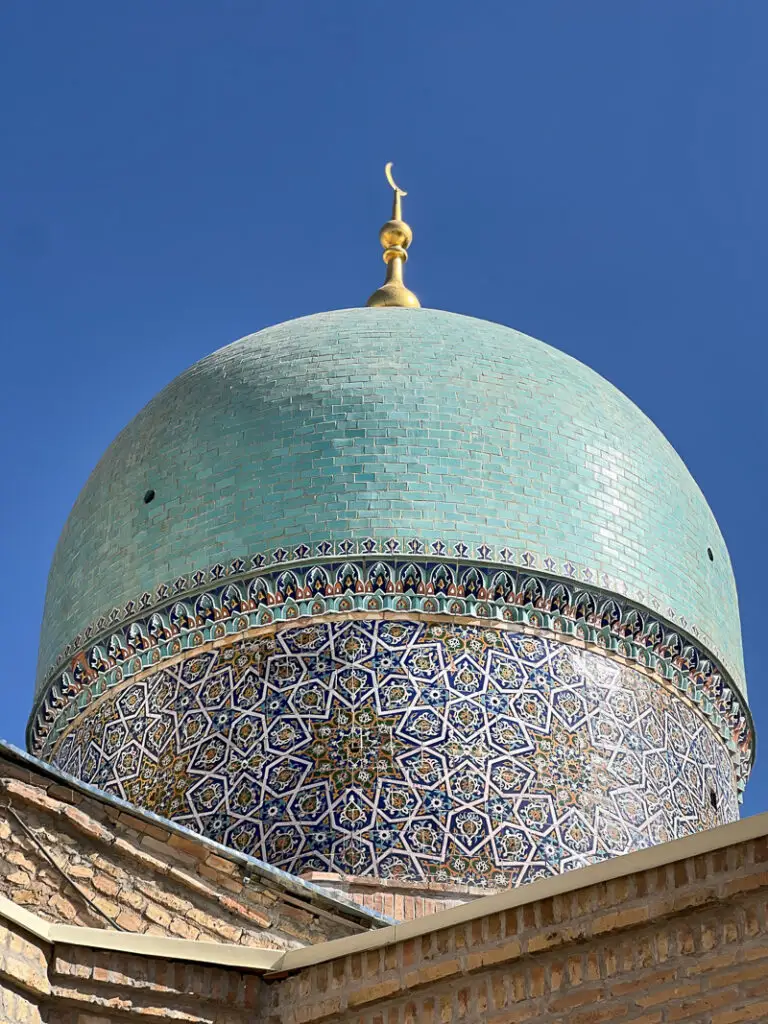
Architecture lovers will fall for the intricate tilework and soaring domes, while food lovers will be equally delighted by sampling plov, lagman noodles, and the endless varieties of warm somsa.
Whether you are chasing Silk Road history or, like us, looking for a destination that blends family-friendliness and culture, Uzbekistan offers the best of both worlds.
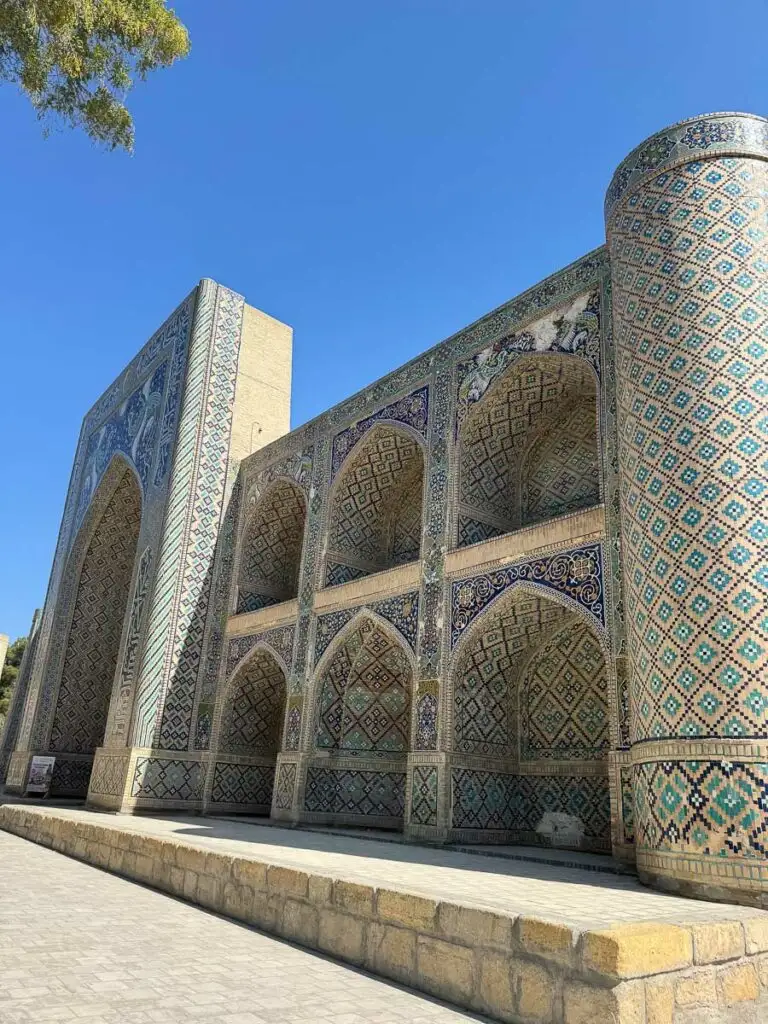
In the detailed Uzbekistan travel itinerary that follows, I will share exactly how we planned our route, along with tips on where to stay, what to eat, and how to keep both kids and parents happy along the way.
Itinerary Uzbekistan Practical Travel Essentials
Connectivity and eSIMs
For staying online, we used an eSIM from Local, which worked flawlessly across Tashkent, Samarkand and Bukhara. It saved us hunting for local SIM cards and kept maps and translation apps running the moment we arrived.
Money and Currency
Uzbekistan’s currency is the Uzbek som. Cash and card is widely accepted and ATMs are readily available in the main cities.
When we needed to send money quickly, we used Paysend to transfer funds directly to local bank cards, which was instant and much easier than dealing with international wire transfers.
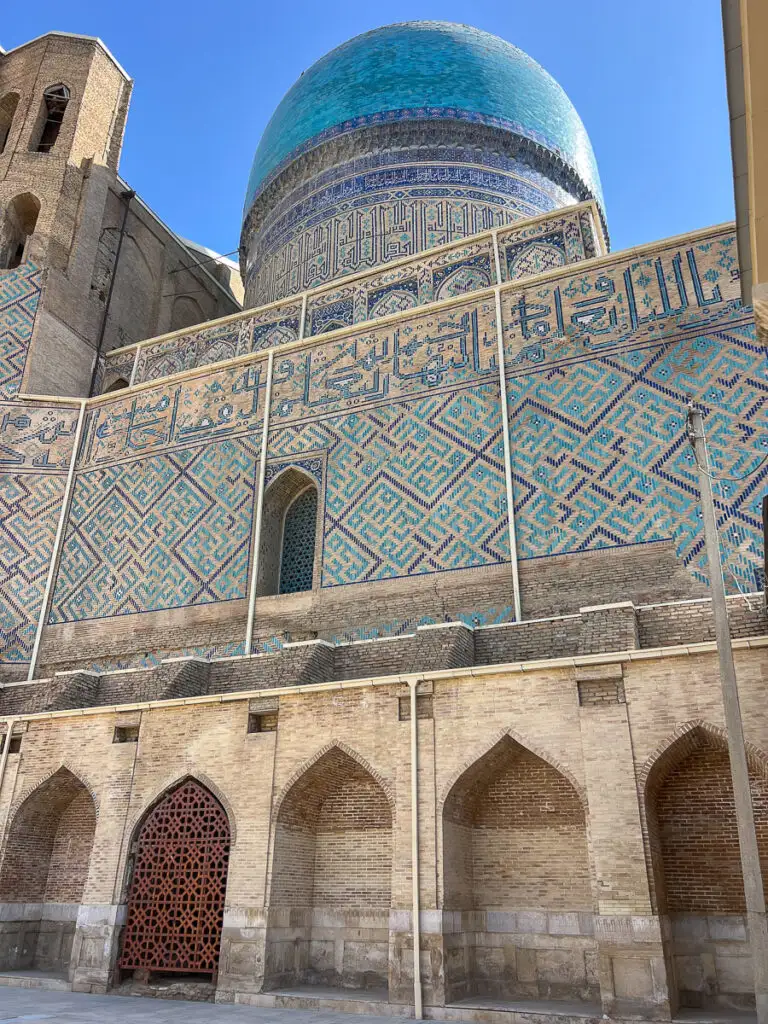
Cleanliness and Safety
One of the most pleasant surprises of our itinerary for Uzbekistan was how clean everything felt. Streets are swept daily, parks are tidy, and even the busiest bazaars are remarkably litter-free. We always felt safe, even when walking with the kids late at night.
Warm and Welcoming People
Uzbek hospitality is legendary. Everywhere we went, people greeted the children with smiles, offered small gifts of fruit or bread.
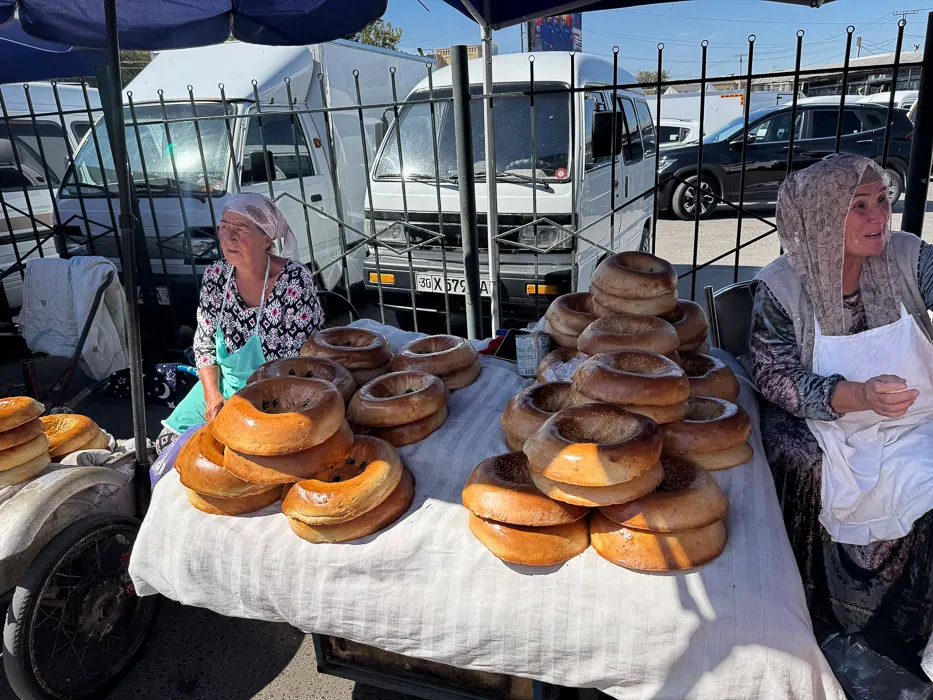
English is not widely spoken once you leave the main tourist spots, but a few words of Russian or a translation app go a long way, and locals appreciate any attempt to communicate.
Language Tips
Uzbek is the official language, written in both Latin and Cyrillic scripts. Russian remains a common language, especially among older generations. We found simple greetings like “salom” for hello and “rahmat” for thank you always brought a friendly response.
Getting Around
Trains are the easiest way to move between cities on an itinerary for Uzbekistan with kids. The high-speed Afrosiyob is comfortable and reliable. Inside the towns, Yandex taxis are inexpensive and convenient, while the Tashkent Metro is worth riding just to admire the beautiful stations.
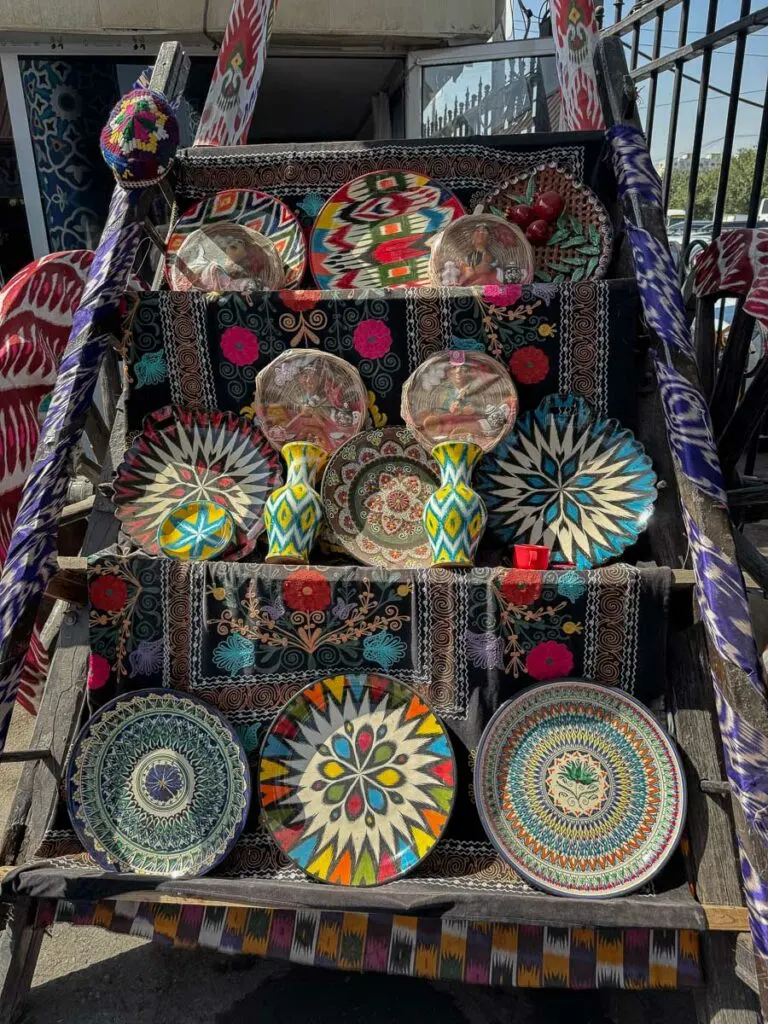
Tashkent: A Gentle Start to Our Uzbekistan Itinerary with Kids
Arriving in Tashkent after a few days in Almaty, Kazakhstan, felt like taking a deep breath. Almaty’s pace and traffic had left us a little frazzled, so the capital of Uzbekistan came as an unexpected retreat.
For a city of more than two million people, Tashkent moves at a slower, more relaxed rhythm. We rented an Airbnb on the outskirts of town, which provided us with quiet evenings and easy access to the sights when we wanted them.
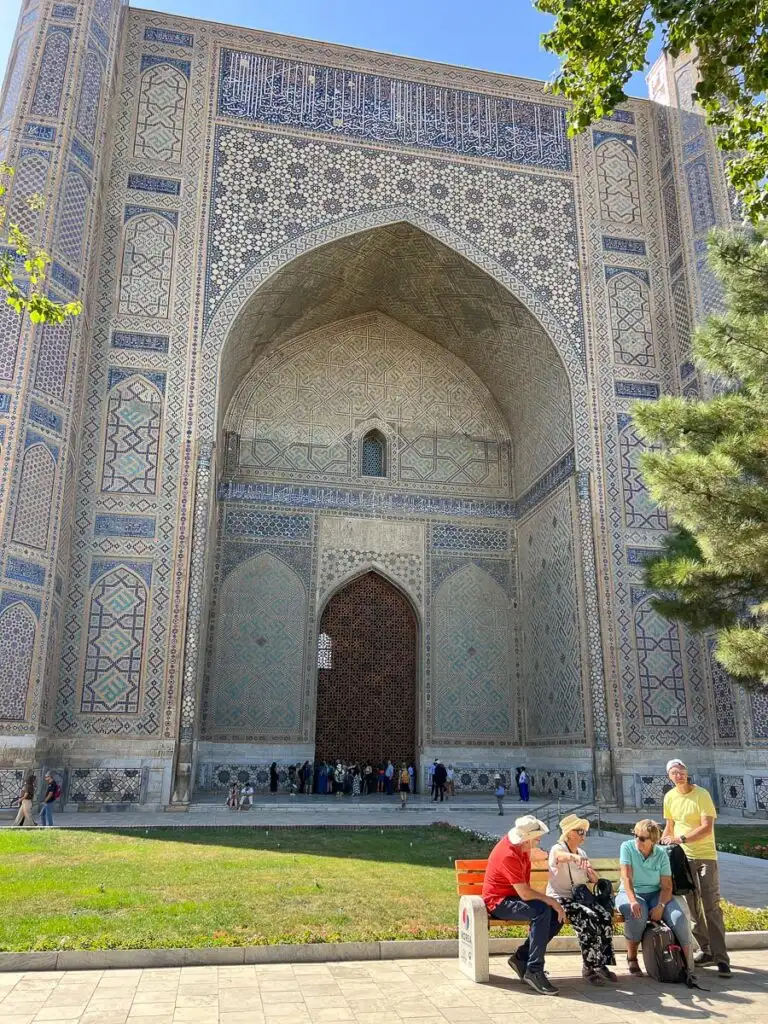
One of the first things that stands out here is the strong Korean influence. Decades of migration have resulted in Korean barbecue spots on almost every street and market stalls selling kimchi alongside Uzbek plov. It is a fun and surprising mix of cultures, and even the kids noticed the change in flavours.
Getting around is effortless. We used the Yandex app for quick rides, but also made a point of riding the metro.
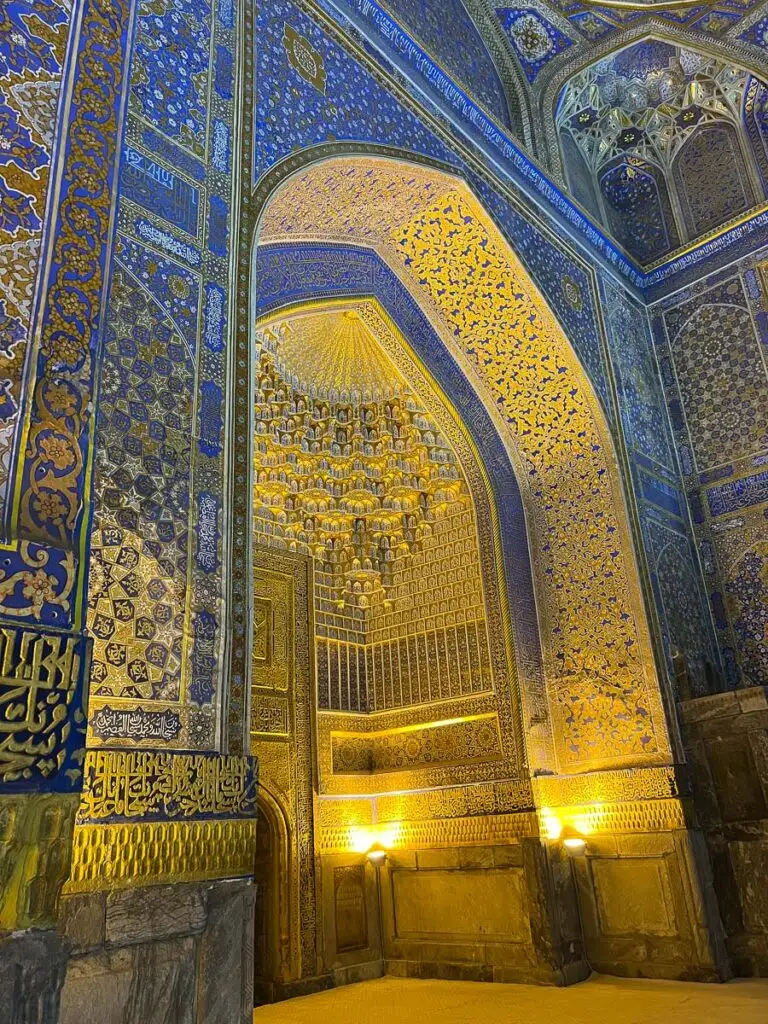
Tashkent’s stations are among the most beautiful in the world, each with its own unique design, marble columns, and chandeliers that evoke a sense of artistry more akin to a gallery than public transportation.
You could stay as long or as short as you like, however I recommend a minimum of two to three days.
Chorsu Bazaar
Our first stop was the vibrant Chorsu Bazaar. The kids loved weaving between the stalls piled high with colourful spices, fresh fruit and warm rounds of bread.
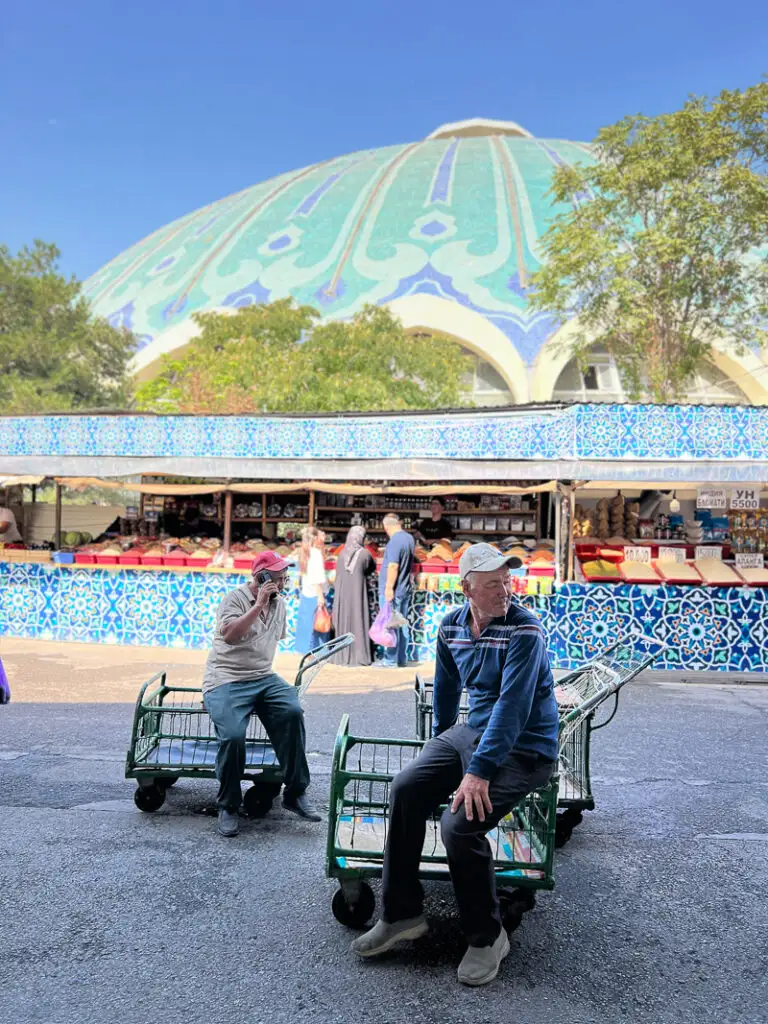
Friendly vendors were happy to offer samples and explain their produce, which turned a simple visit into a mini cooking lesson.
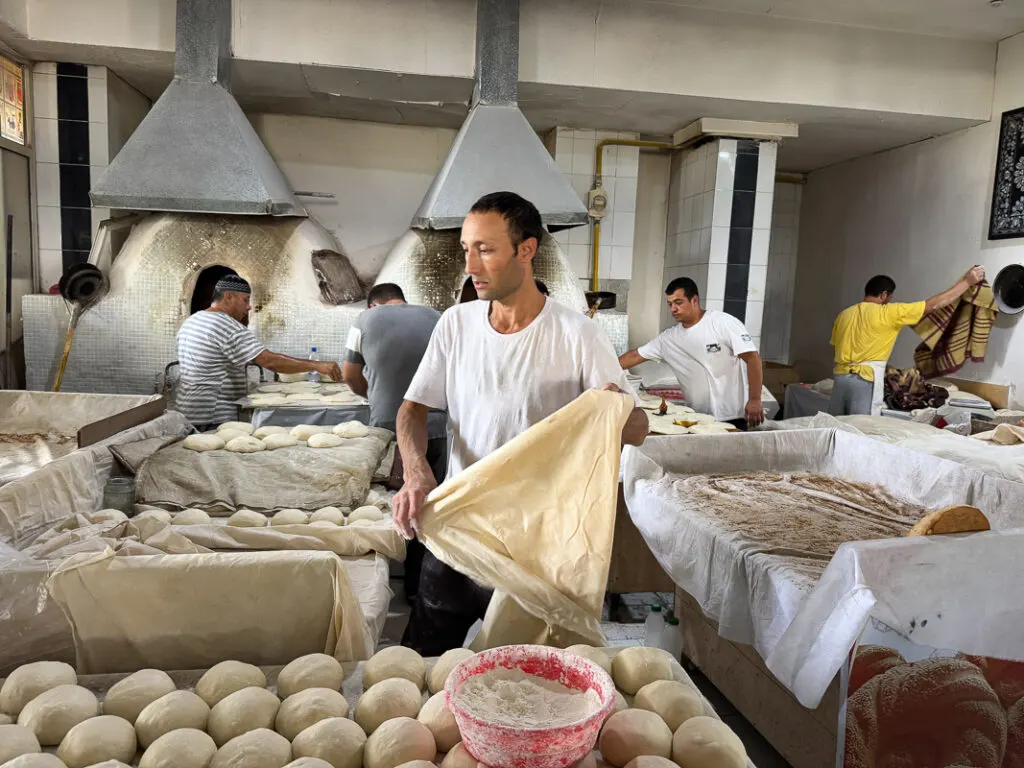
Plov Centre
Next, we headed to the famous Plov Centre where giant cauldrons of rice, meat and carrots bubble away over open flames.
Watching the chefs stir the steaming pots is an experience in itself, and the dish tastes even better when eaten fresh. We lingered to watch the steady rhythm of the cooks who serve hundreds of hungry locals every lunchtime.
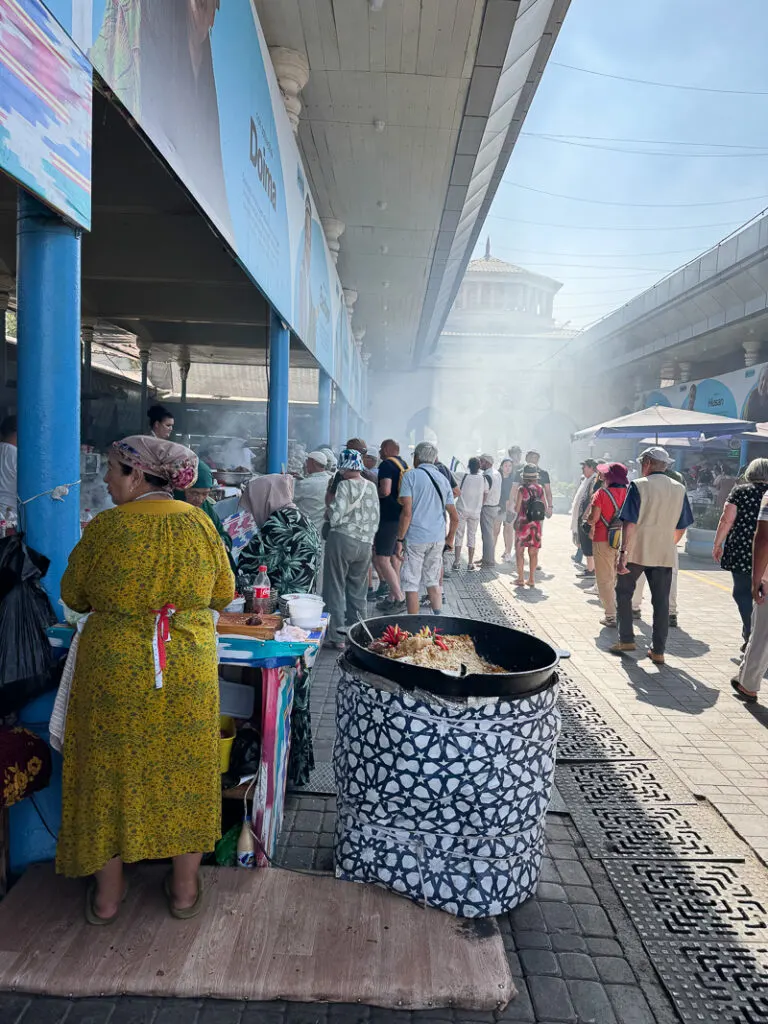
Tashkent City Park and Mall
For an afternoon break, we explored Tashkent City Park and the adjoining shopping mall. There are shaded paths, small playgrounds and plenty of space for the children to run around. The modern cafés and ice cream stands make it easy to reward little legs after a morning of sightseeing.
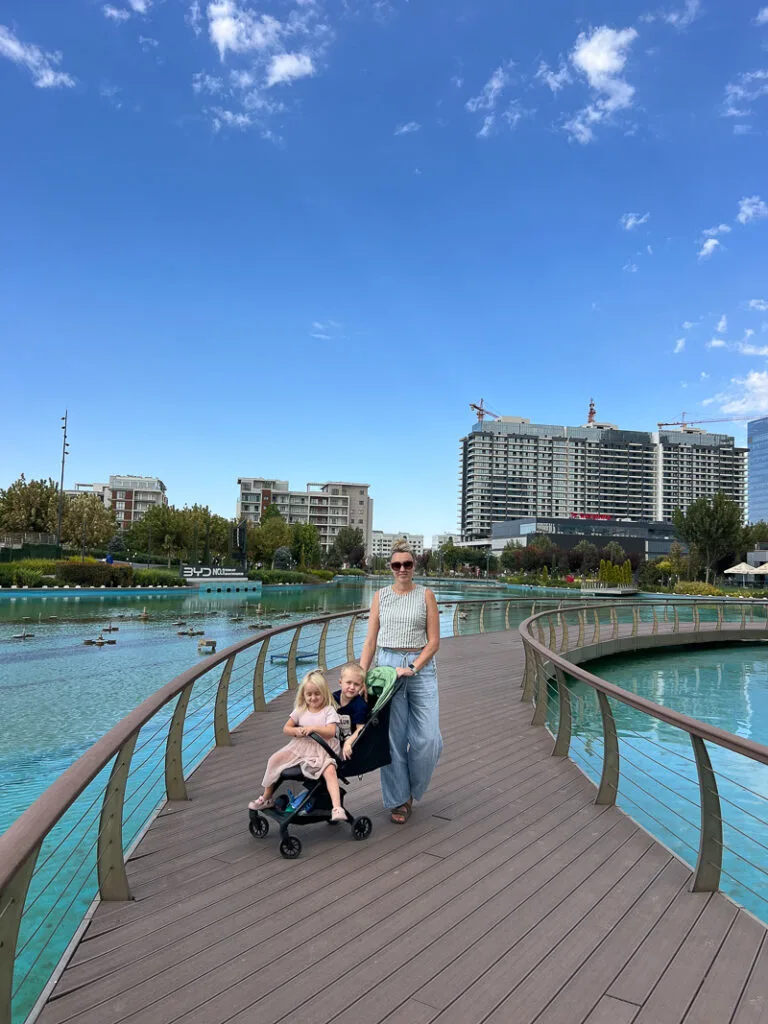
SkyPark Indoor Adventure Space
Skypark at Tashkent City Mall is one of the most incredible indoor play areas we have ever visited. It features a space theme that instantly captures kids’ attention, with slides that drop three stories, giant bungee swings, zip lines, and numerous soft play and climbing areas spread across multiple levels.
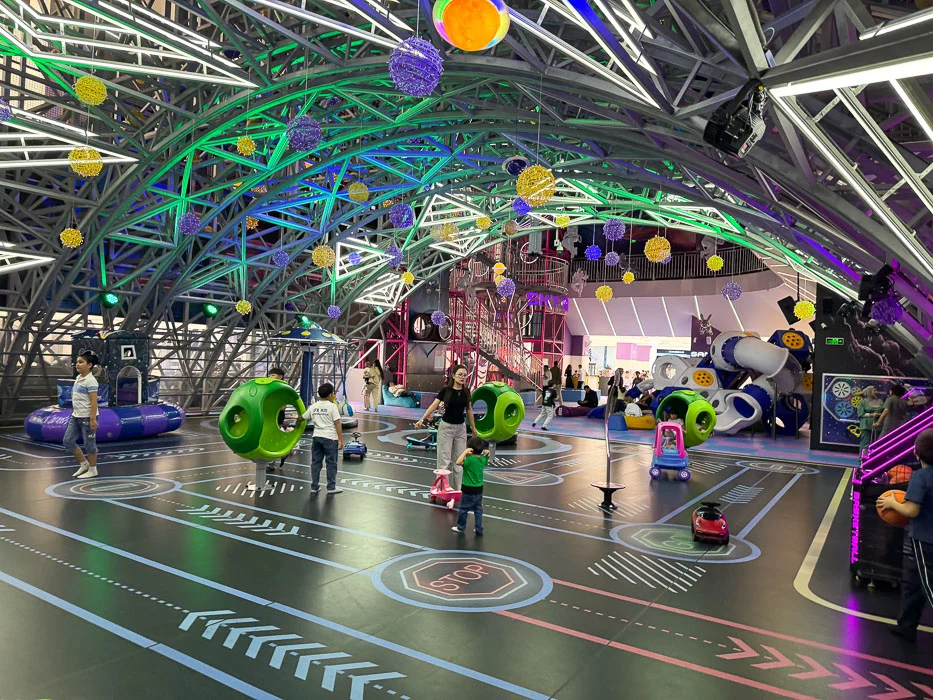
My kids were absolutely obsessed, and we ended up spending the entire day there because they didn’t want to leave. It’s exciting, safe, and perfect for a wide range of ages, from little ones to older kids who love adventure. Skypark really takes indoor play to another level.
Hazrati Imam Mosque Complex
The Hazrati Imam complex is a peaceful contrast to the bustle of the bazaar. Intricate blue tiles, quiet courtyards, and elegant minarets make it a beautiful place to slow down and take in the city’s history.
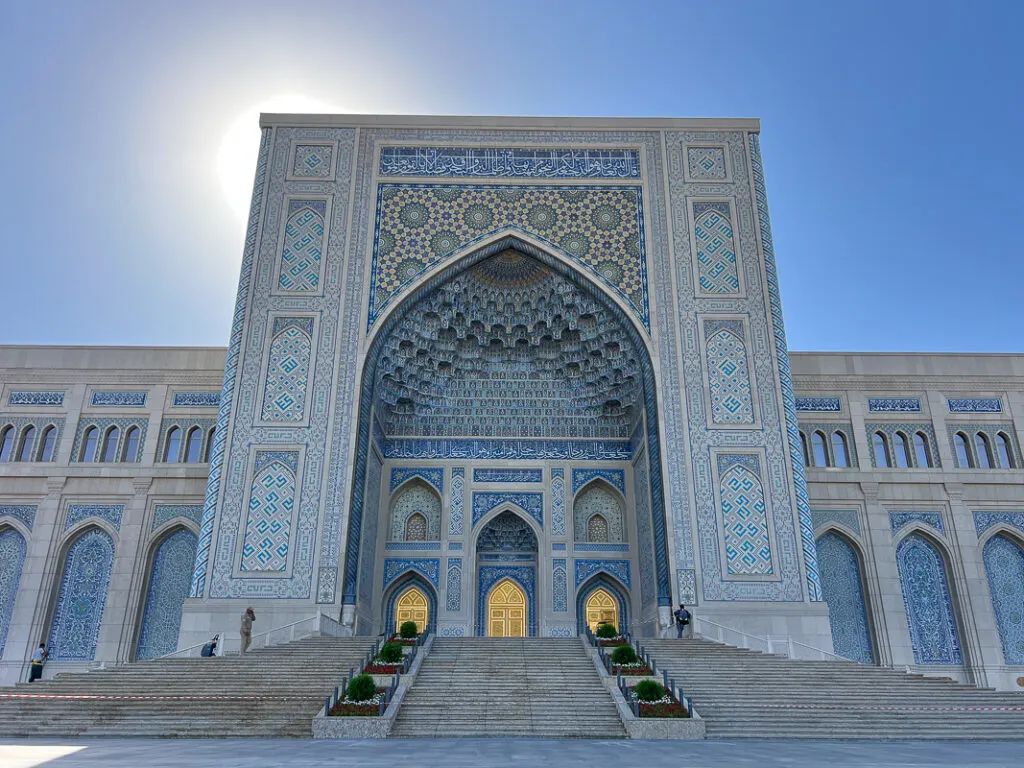
We visited at a time when there was some restoration works taking place, however there was still plenty of corners and sides to the building to explore, the complex is huge!
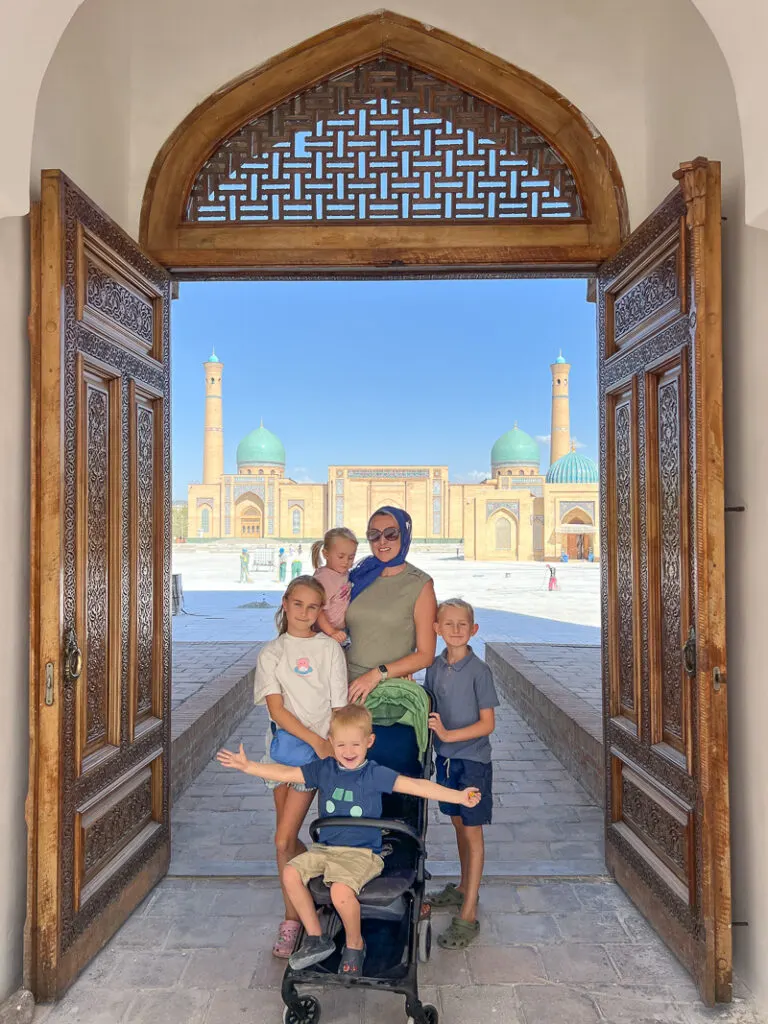
Magic City
As evening approached, we walked to Magic City, a whimsical entertainment area that lights up at night. It feels a little like a free, open-air version of Disneyland, with colourful lights, playful architecture and plenty of space to stroll.
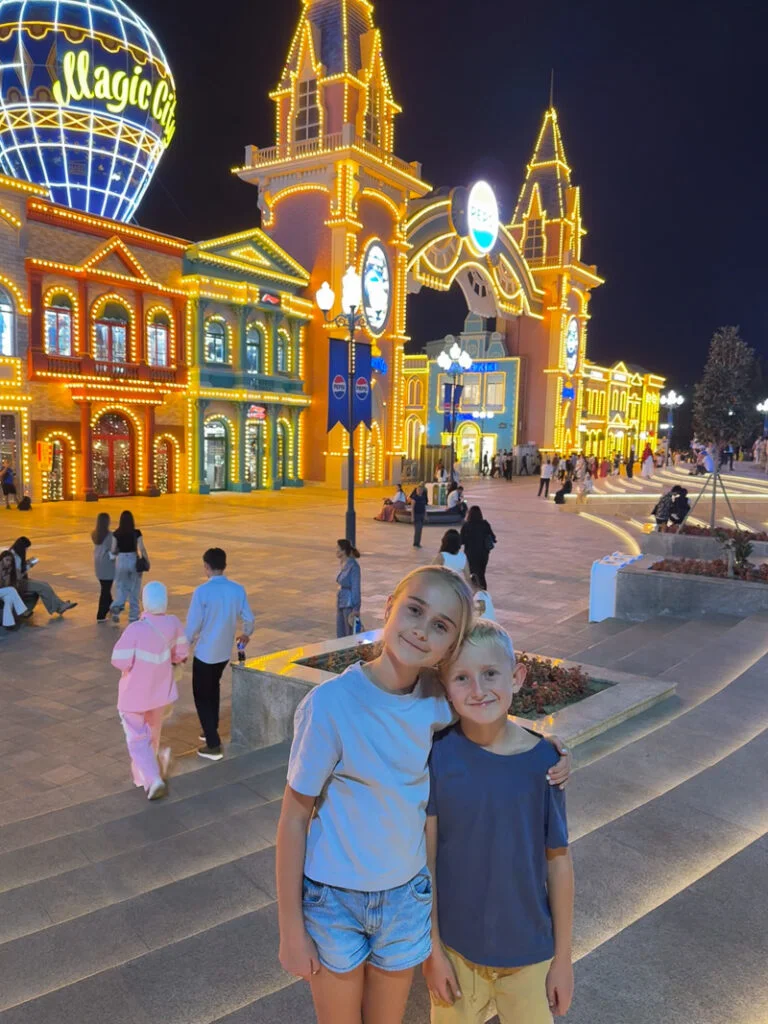
Street performers and live music added to the sense of excitement, keeping the children entertained long after sunset.
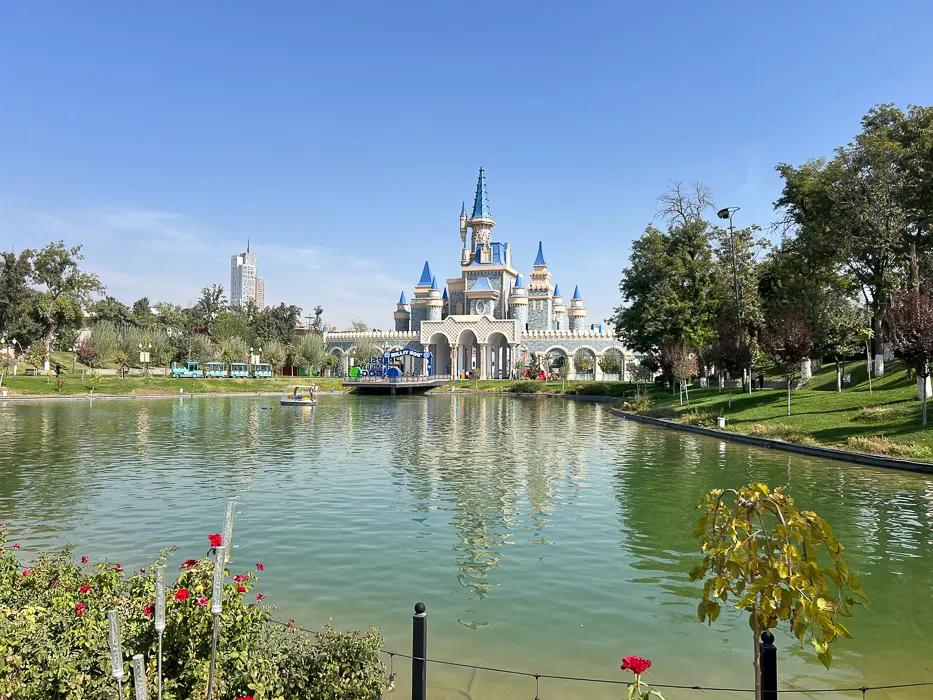
There are some rides in here, including a zipine that goes above the central water feature. However a minimum weight of 40kg is required. Our younger kids enjoyed the carousel and our older kids enjoyed the giant slide.
Seul Mun Canal and Water Show
We finished the day along the Seul Mun canal, where fountains burst into life after dark. The evening water show combines music and lights, creating a fun atmosphere and a perfect end to our first day in Uzbekistan.
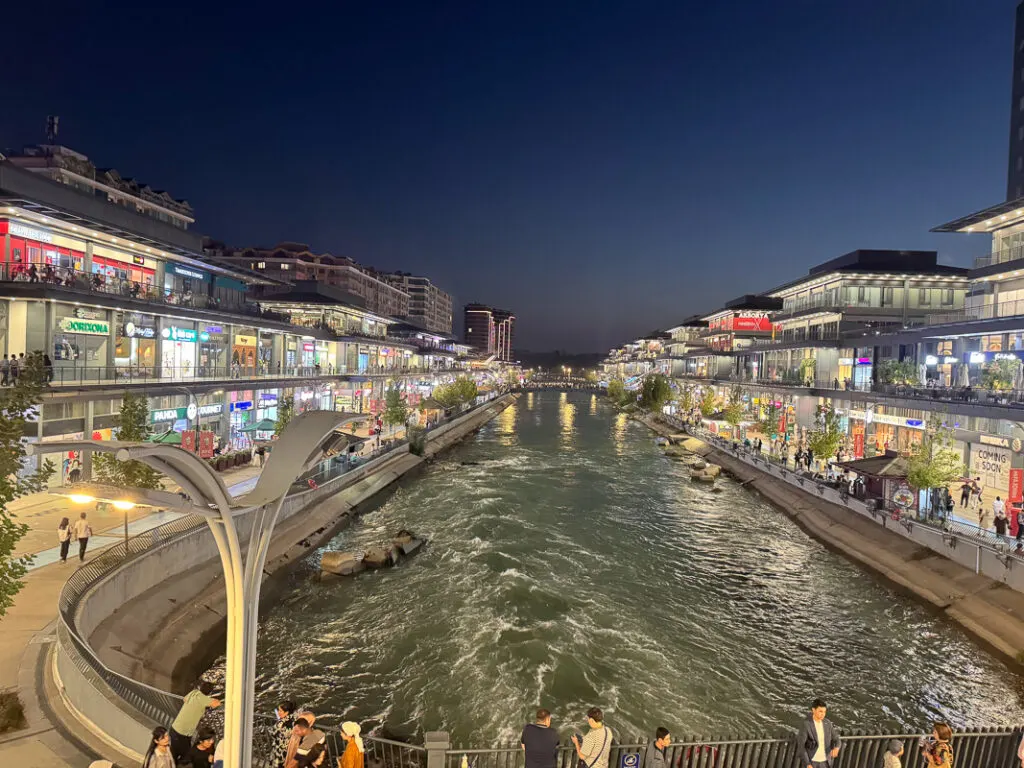
There are many restaurants and cafes around the edges and we even saw a pop-up market taking place, it’s the perfect spot to grab an ice-cream. It’s also walking distance to the Magic City so you could in theory do both of these in one evening.
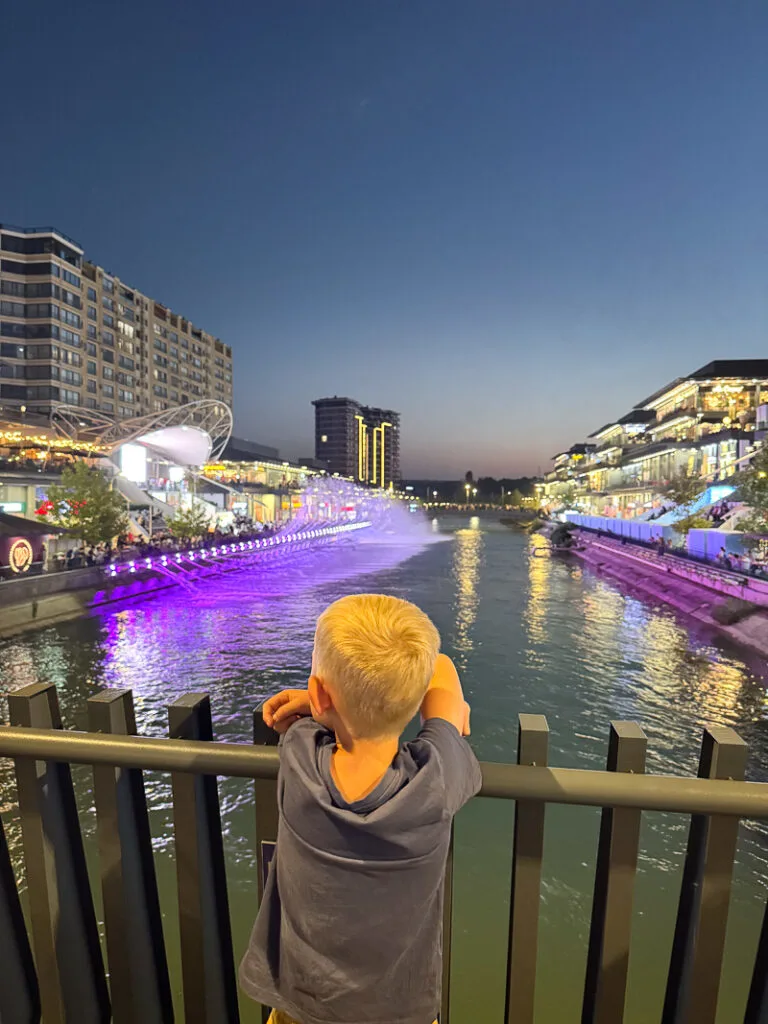
Samarkand With Kids
Once we finished with all of the sites in Tashkent it was time to take the Afrosiyob high-speed train to Samarkand. It was smooth and comfortable, with wide seats and spotless carriages.
The scenery outside was striking in its own way, just long stretches of dry open land broken only by the occasional cluster of low hills or a small settlement.
Samarkand has been a cultural crossroads for over two thousand years. Once a key stop on the Silk Road, it drew traders, scholars and conquerors from Persia, India, China and beyond.
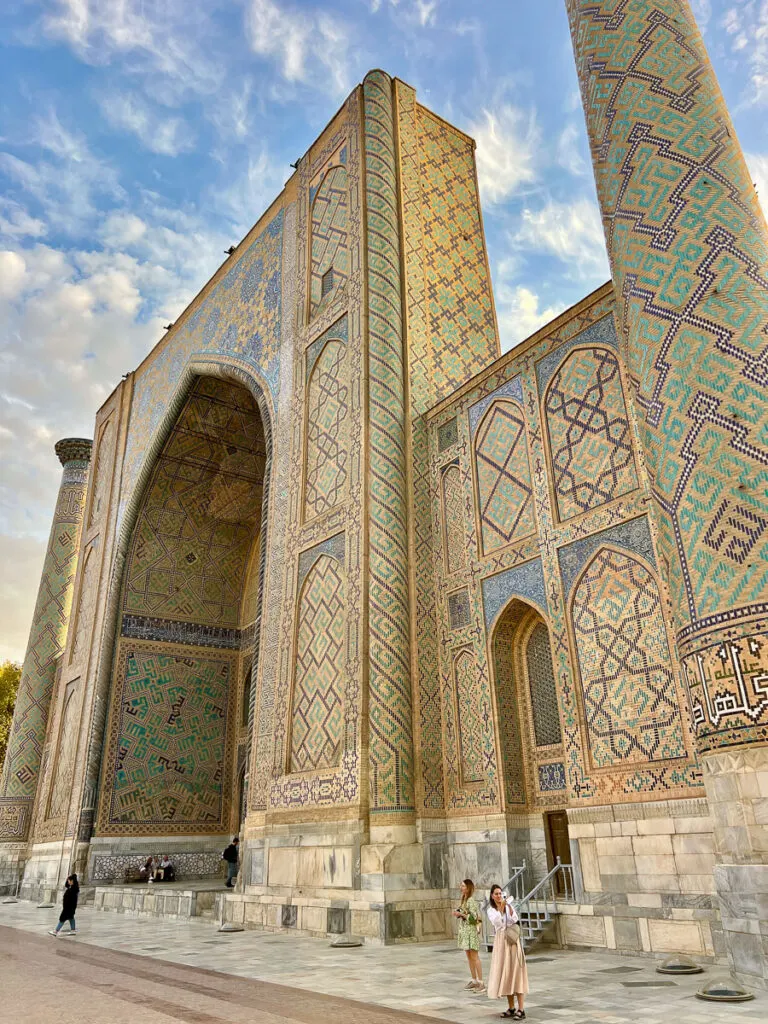
Including Samarkand in an itinerary for Uzbekistan with kids gives families a chance to step directly into that history and see how cultures once mixed along these routes.
Today, the city still wears that history proudly in its turquoise domes, mosaic-covered madrasas and fragrant food markets.
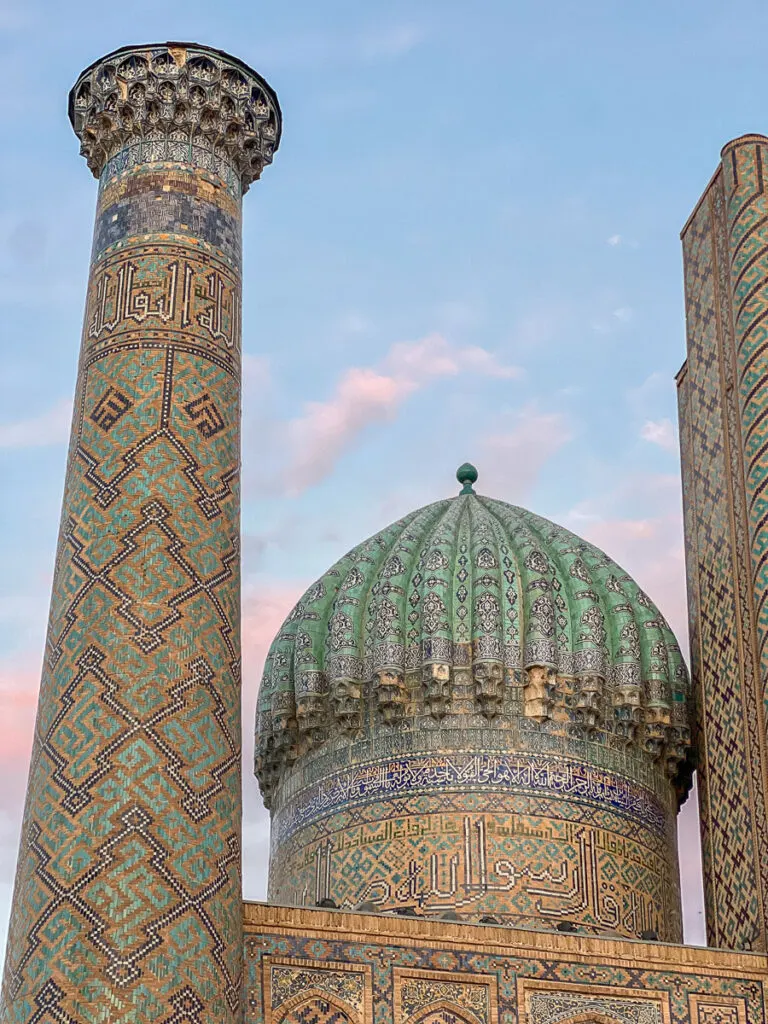
What amazed us most was the architecture. The Registan Square alone is a masterpiece: three grand madrasas covered in brilliant blue and gold tiles that shimmer differently as the light changes through the day.
Across the city, soaring minarets and intricate geometric patterns tell stories of science, religion and art that flourished here long before Europe’s Renaissance.
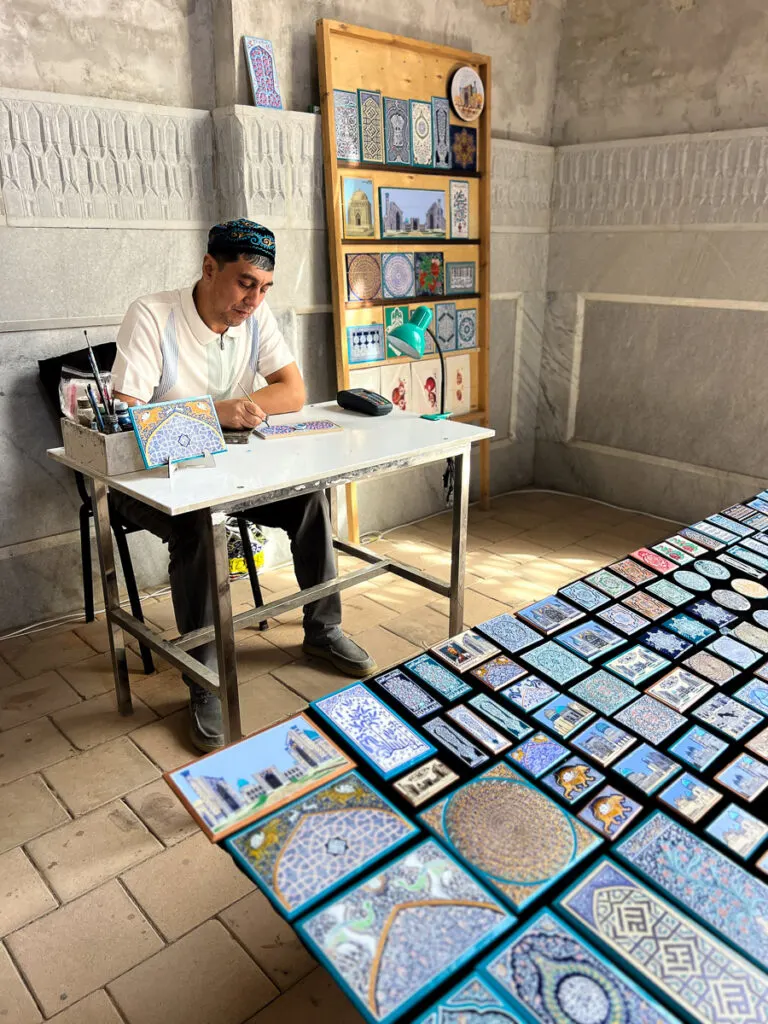
Even small neighbourhood mosques reveal ceilings painted like starry skies and doorways carved with delicate floral designs. .
Since we spent several days here as part of our Uzbekistan itinerary, we had time to explore beyond the famous landmarks. Away from the main squares, we found quiet neighbourhoods, hidden courtyards and small teahouses that many visitors miss.
The city can feel a little dusty and worn around the edges, especially compared with the modern polish of Tashkent.
Villa Konigil
One of our favourite discoveries was Villa Konigil, a working heritage site a little way out of town. The old water mill continues to power the production of delicate mulberry paper, and we watched as artisans demonstrated every stage of the process.
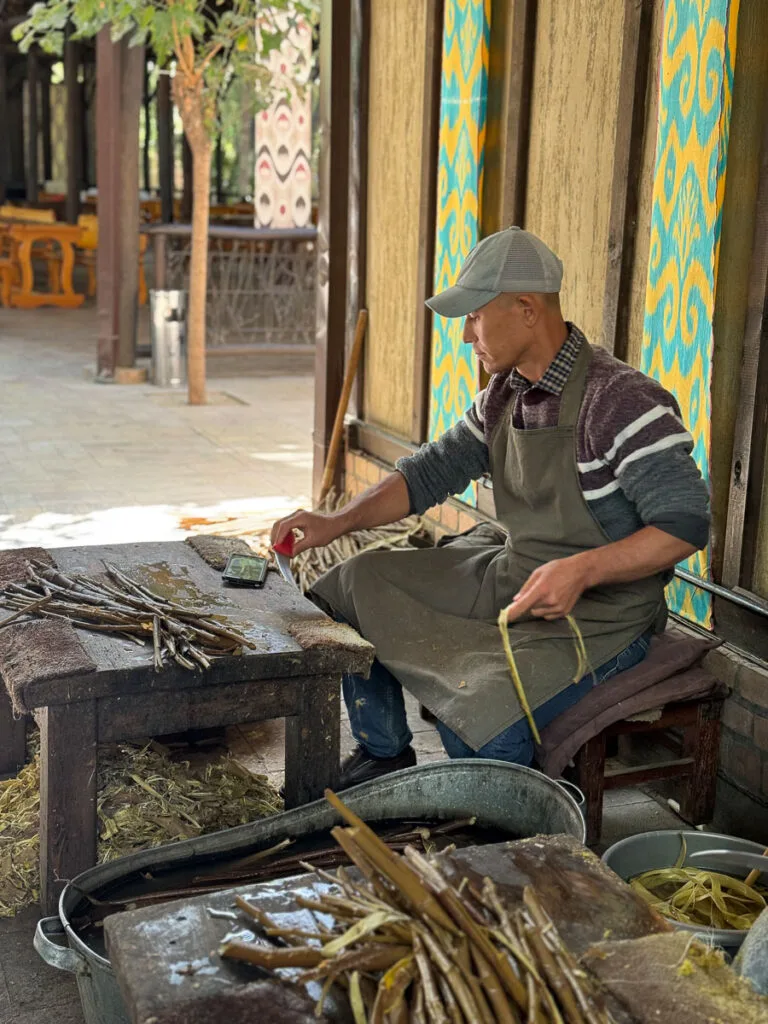
Along the canal that runs through the centre, you can also meet pottery makers and textile craftsmen creating traditional clothing and decorative pieces.
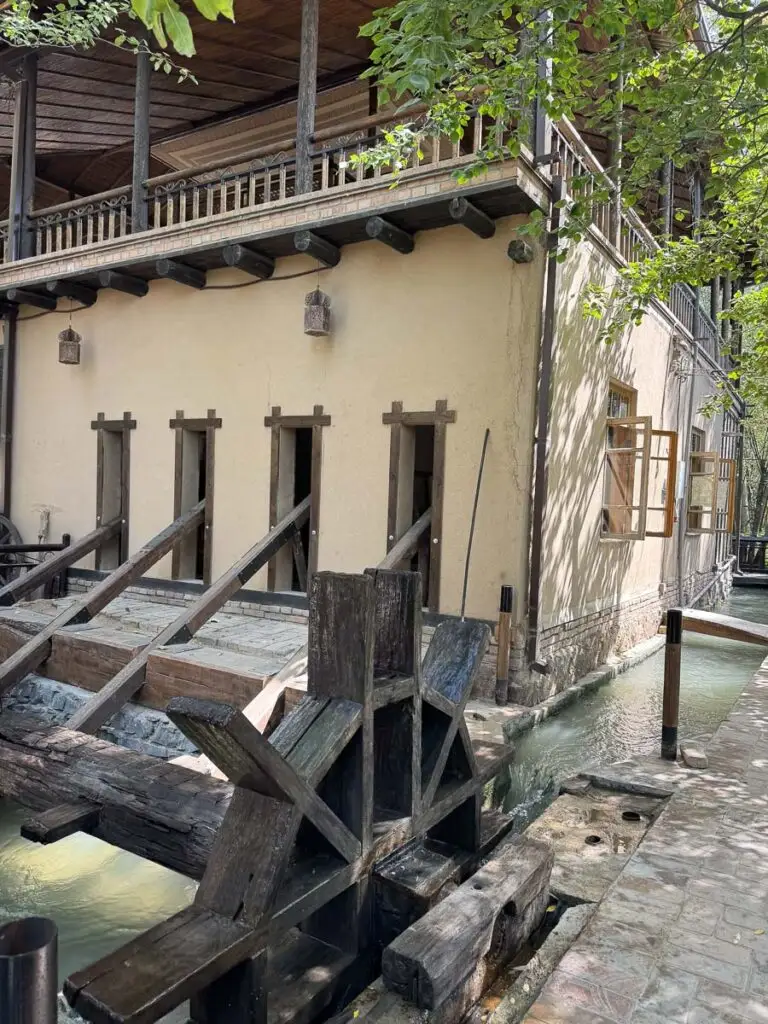
There is no restaurant on-site, but the gift shop offers a selection of beautiful, handmade paper goods. It is absolutely worth the short journey for anyone planning an itinerary for Uzbekistan that goes beyond the main monuments.
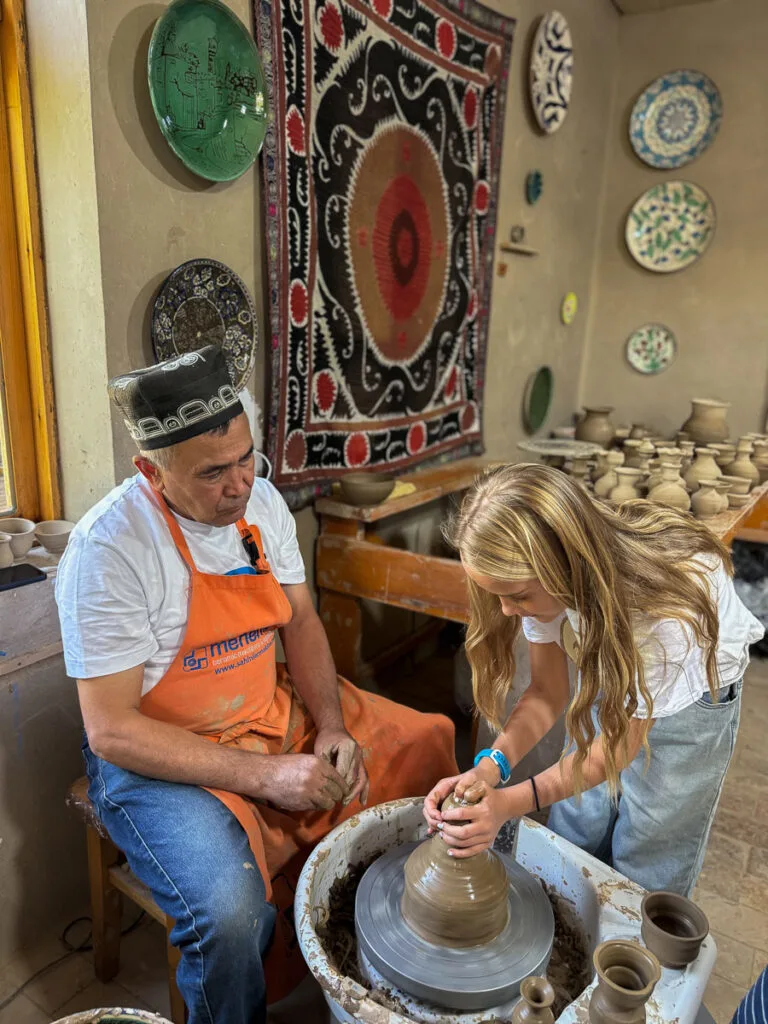
Registan Square
No trip to Samarkand is complete without standing in the middle of Registan Square. Three immense madrasas covered in shimmering blue and gold tiles form one of the most breathtaking ensembles in Central Asia.
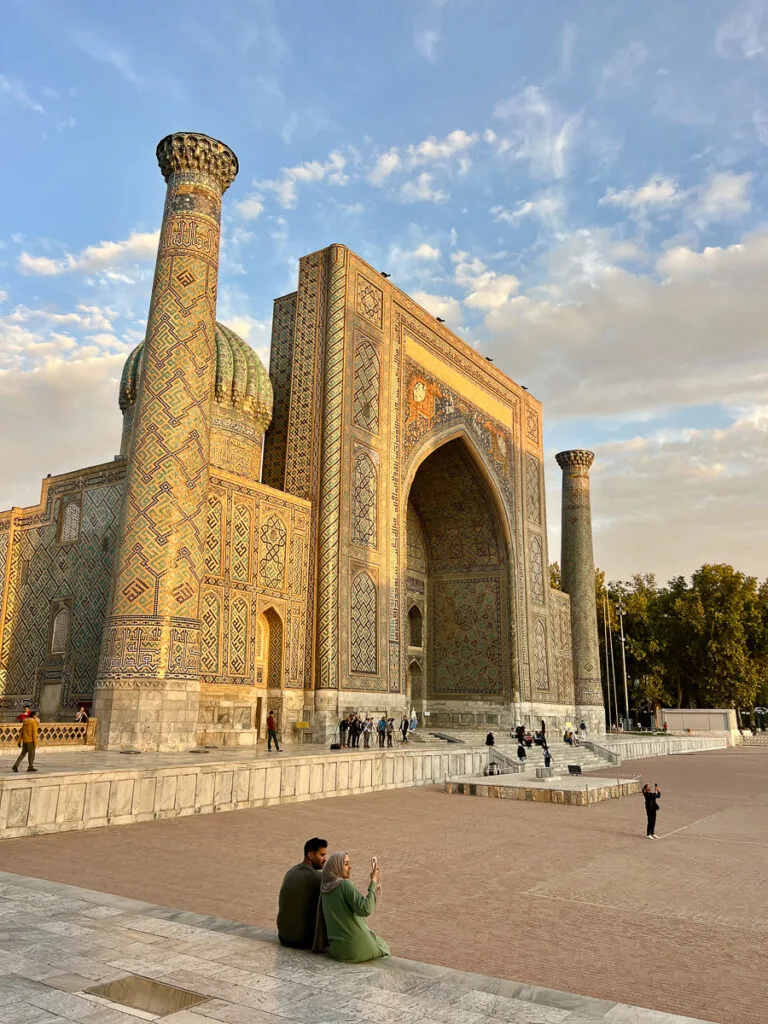
We timed our visit for the evening when the lights make it look completely different. infact there is a light show at 9pm, unfortunately we never last until that time with twin toddlers.
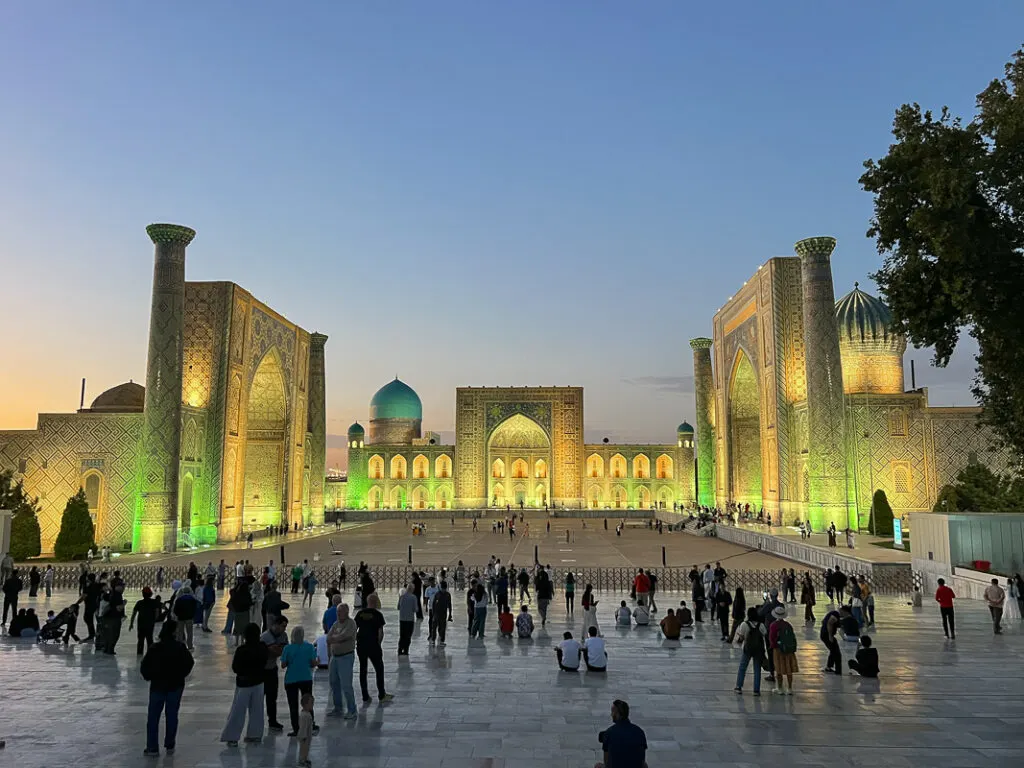
After exploring, we enjoyed dinner at Emirkan, a rooftop restaurant overlooking the square with excellent Uzbek dishes and unforgettable views.
Hazrat Khizr Mosque
Perched on a hill with sweeping views of the city, Hazrat Khizr Mosque is a serene place to pause. The wooden columns and carved ceilings are as impressive as the panorama.
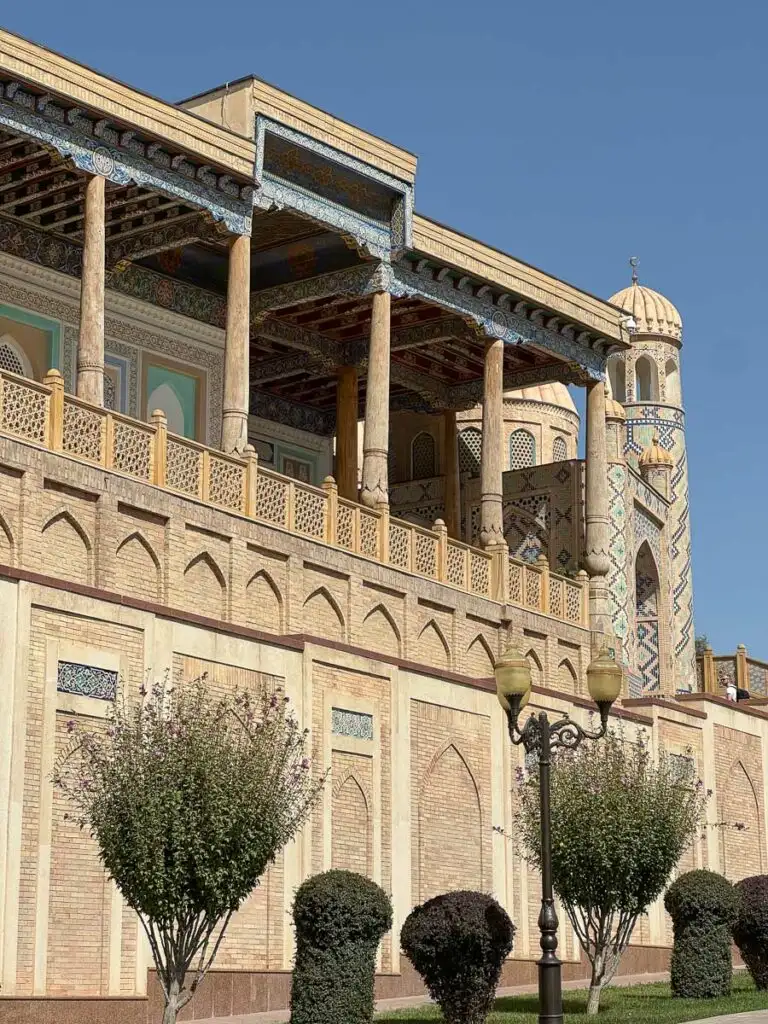
Siyob Bazaar
For a taste of everyday life, we wandered through Siyob Bazaar. Stalls overflow with fruit, nuts, spices and fresh bread, and there is a small restaurant in the centre serving hearty plov that became a family favourite.
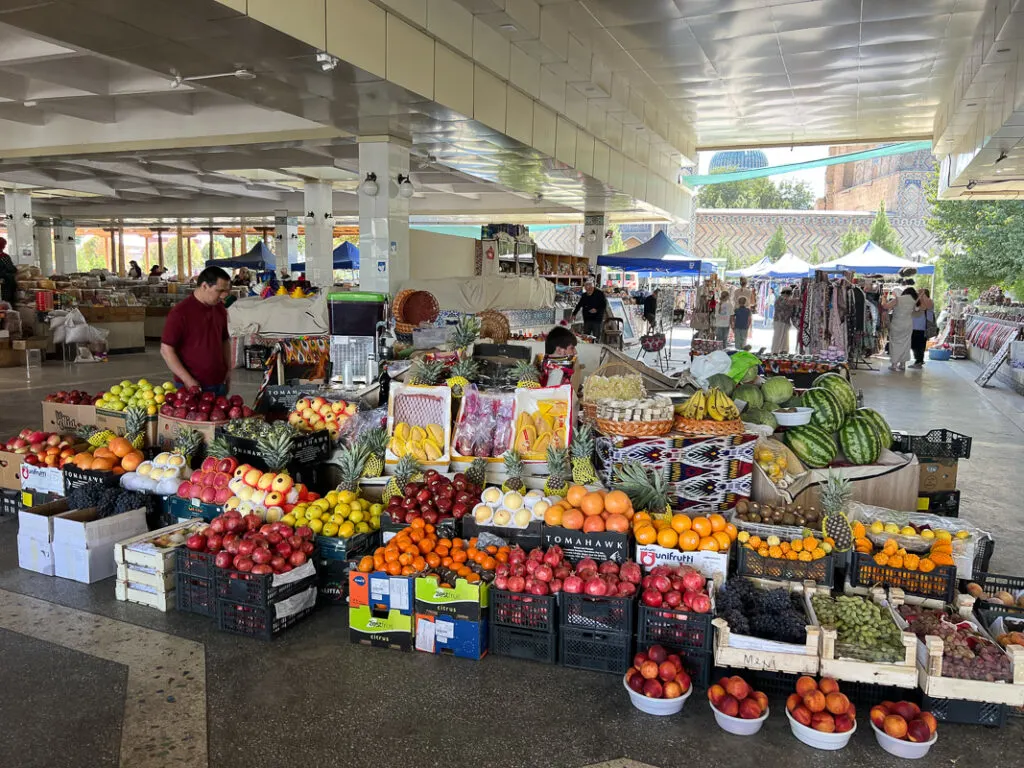
Including these markets in an itinerary for Uzbekistan with kids is an easy way to keep little travellers entertained while sampling local flavours.
Shah-i-Zinda
Shah-i-Zinda is perhaps the most beautiful site in the entire country. A long avenue of tiled mausoleums glitters in every shade of turquoise and cobalt, and the craftsmanship is breathtaking. We spent extra time here to take in the detail and atmosphere.
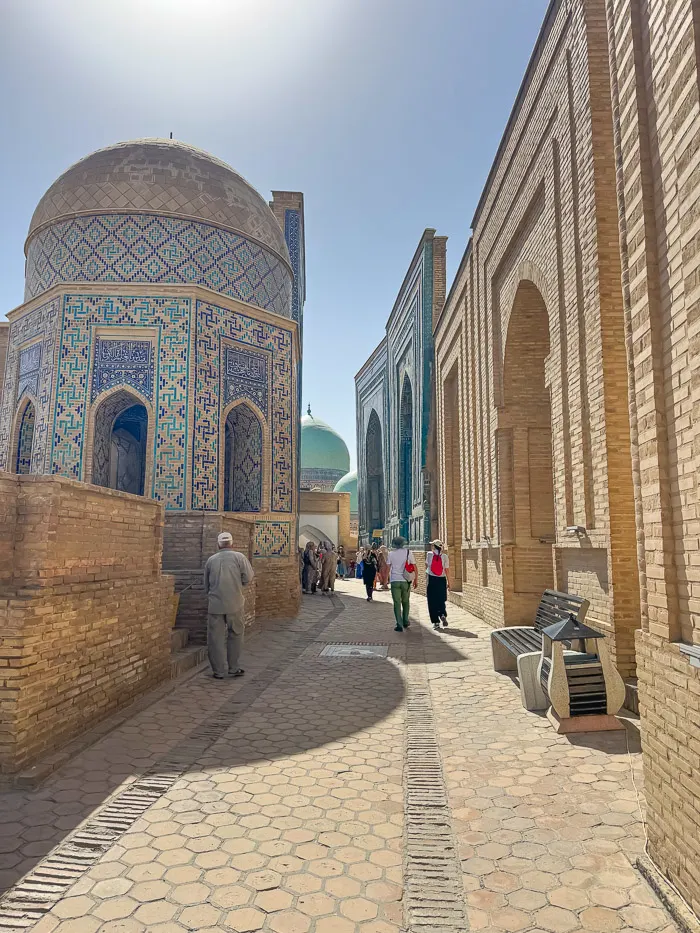
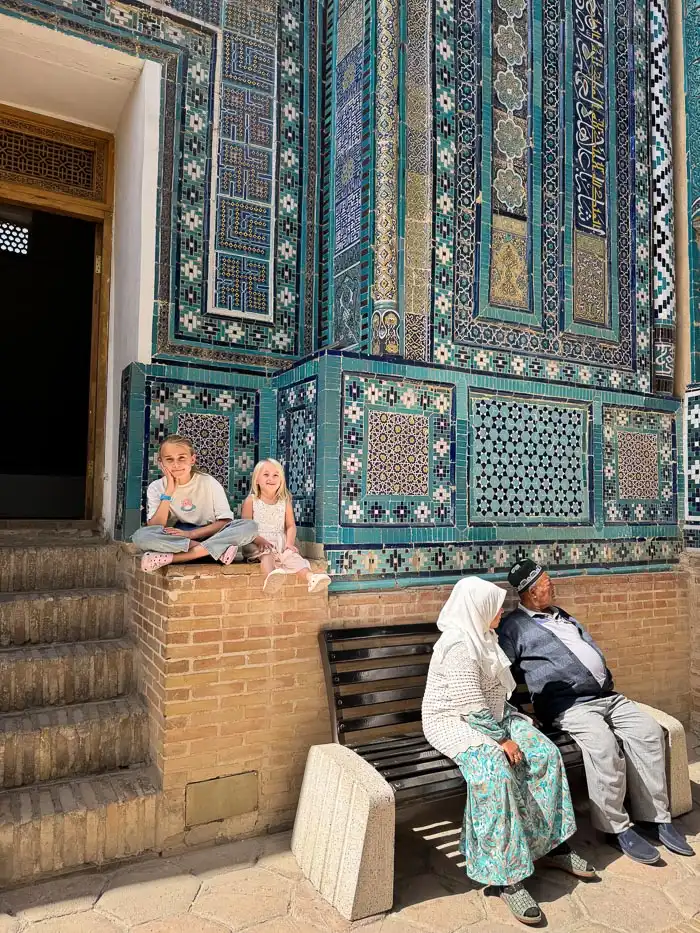
Central Park
When we needed a change of pace, we headed to Central Park. Wide paths, shady trees and small amusement rides gave the children space to run while we enjoyed relaxing on the bench.
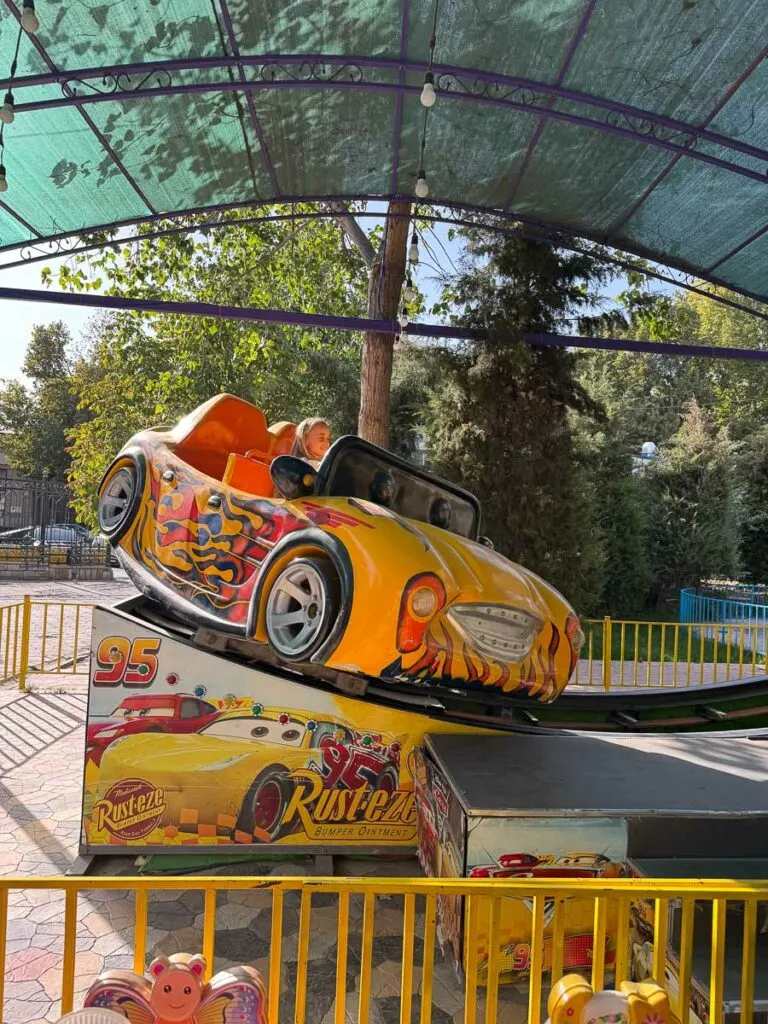
Boulevard Bakery
We had lunch at Boulevard Bakery on University Boulevard, a modern and surprisingly swanky café that feels worlds away from the old Silk Road streets.
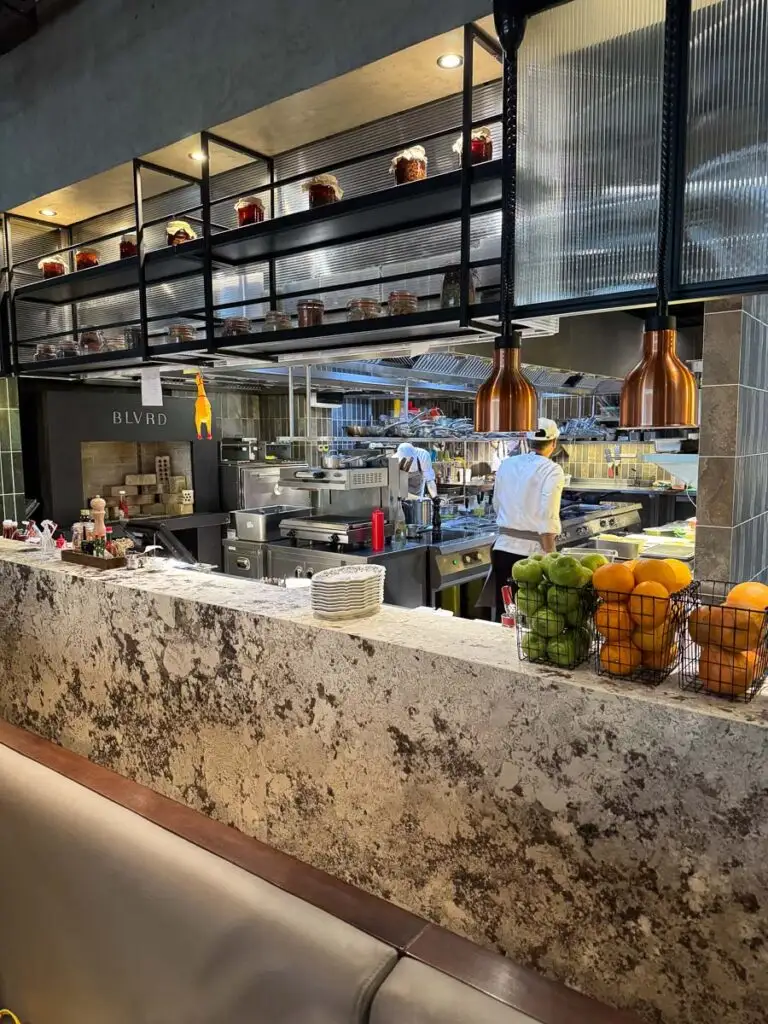
It is on the pricier side for Samarkand, but worth it if you are craving something different, with beautifully presented dishes like fancy avocado toast and a perfectly made matcha latte.
The calm interior and friendly staff made it a great spot to treat ourselves after days of exploring as part of our itinerary for Uzbekistan.
Overnight or Day Trp To Tajikistans Seven Lakes
With Samarkand sitting so close to the Tajik border we decided to add a spontaneous overnight adventure into Tajikistan, crossing at Panjakent to explore the Seven Lakes in the Fann Mountains.
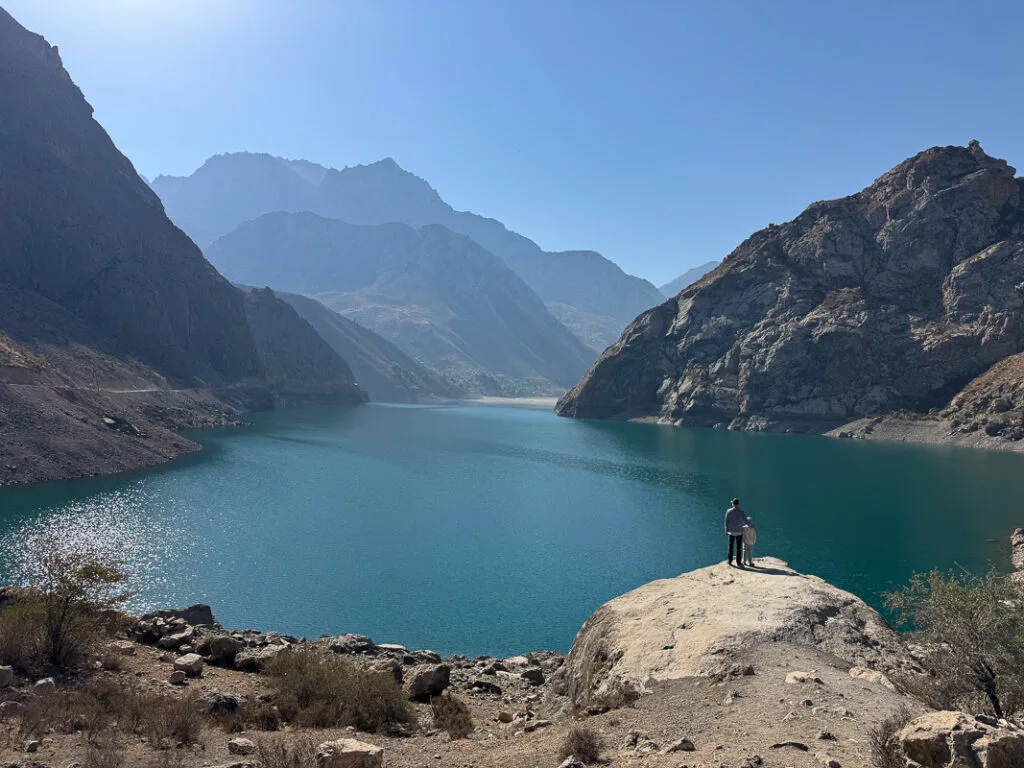
The border formalities were straightforward but the journey had a real sense of adventure, with winding mountain roads and tiny villages along the way. Each lake shimmered in a different shade of blue or green, framed by dramatic cliffs and quiet forests.
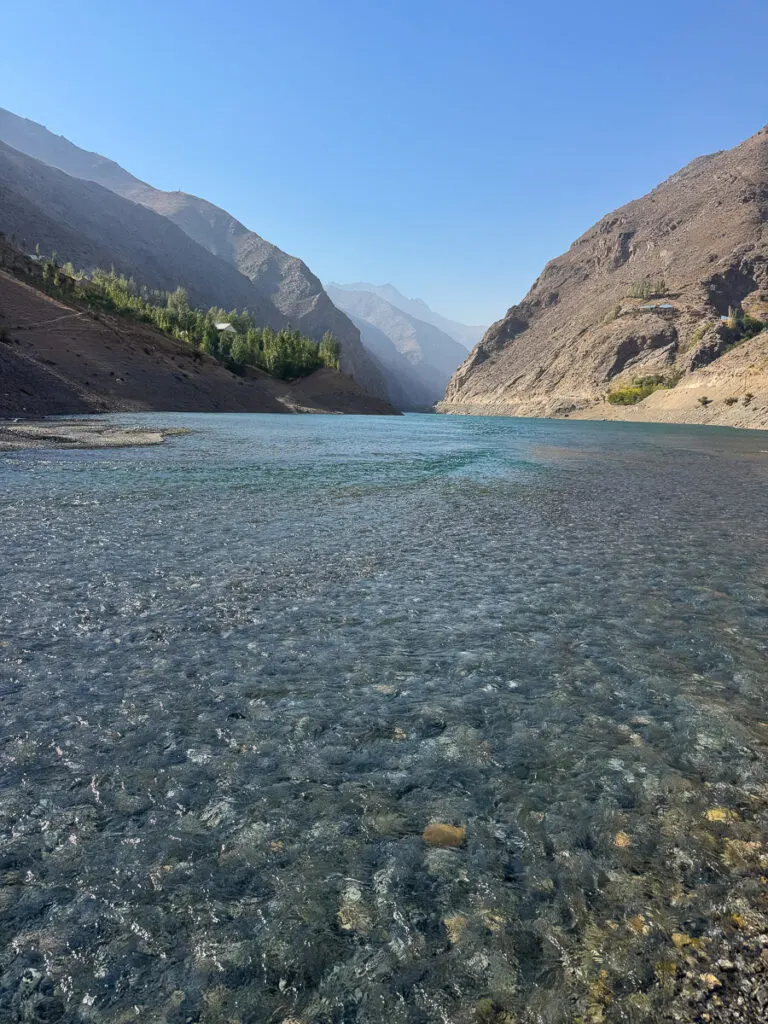
We hired a local driver and stayed with a welcoming family in a simple guesthouse, which gave us a glimpse of rural Tajik life far from the main tourist trail. It was an unforgettable experience, but one I would recommend only to the most intrepid of families who are comfortable with a long day of travel and the unpredictability that comes with crossing into a new country.
Bukhara – An Ancient Town Worth the Extra Journey
When we finished our time in Samarkand, we wondered whether it was worth travelling any farther west, but adding Bukhara to our itinerary for Uzbekistan turned out to be one of the best decisions of the trip.
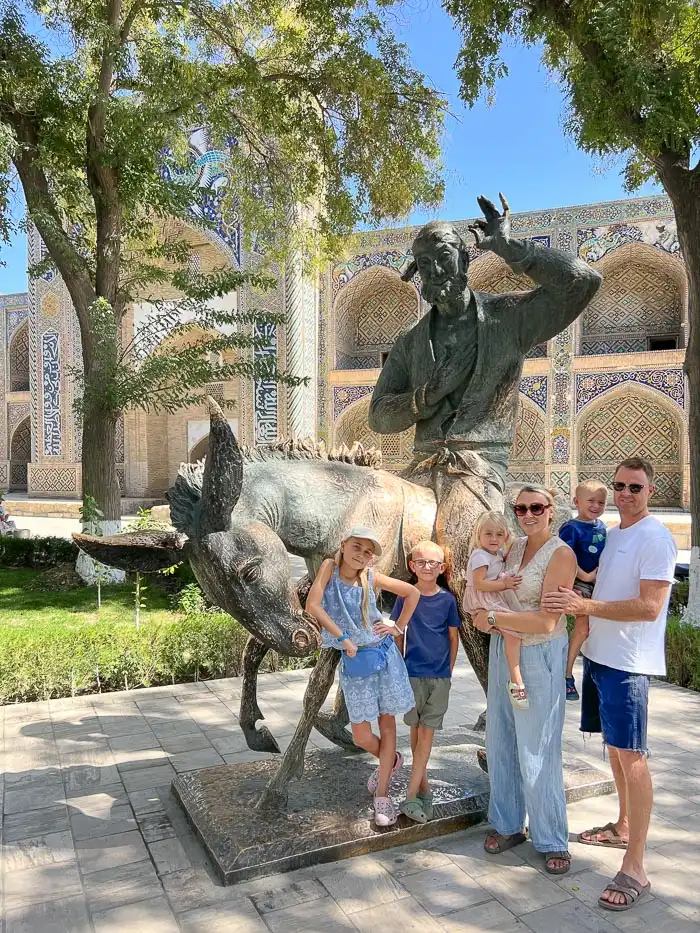
The Afrosiyob high-speed train carried us there from Samarkand in just under two hours, an easy ride with wide seats and plenty of space for the kids to stretch out.
Bukhara immediately felt different from the other cities we had visited. Its pedestrian-only cobbled streets and centuries-old architecture reminded us of the best preserved historic towns we have explored around the world, places like Hoi An in Vietnam, Galle in Sri Lanka and Dubrovnik in Croatia.

The entire old city invites you to wander slowly, stopping for tea under shady mulberry trees or peeking into hidden courtyards where artisans still work by hand.
Most guides online seem to focus on the famous Kalon Minaret, the soaring brick tower that has watched over the city for nearly nine hundred years.
Yet we were delighted to discover that Bukhara offers so much more than a single landmark. Around every corner, we found blue tiled mosques, quiet caravanserais, tiny workshops and open squares.
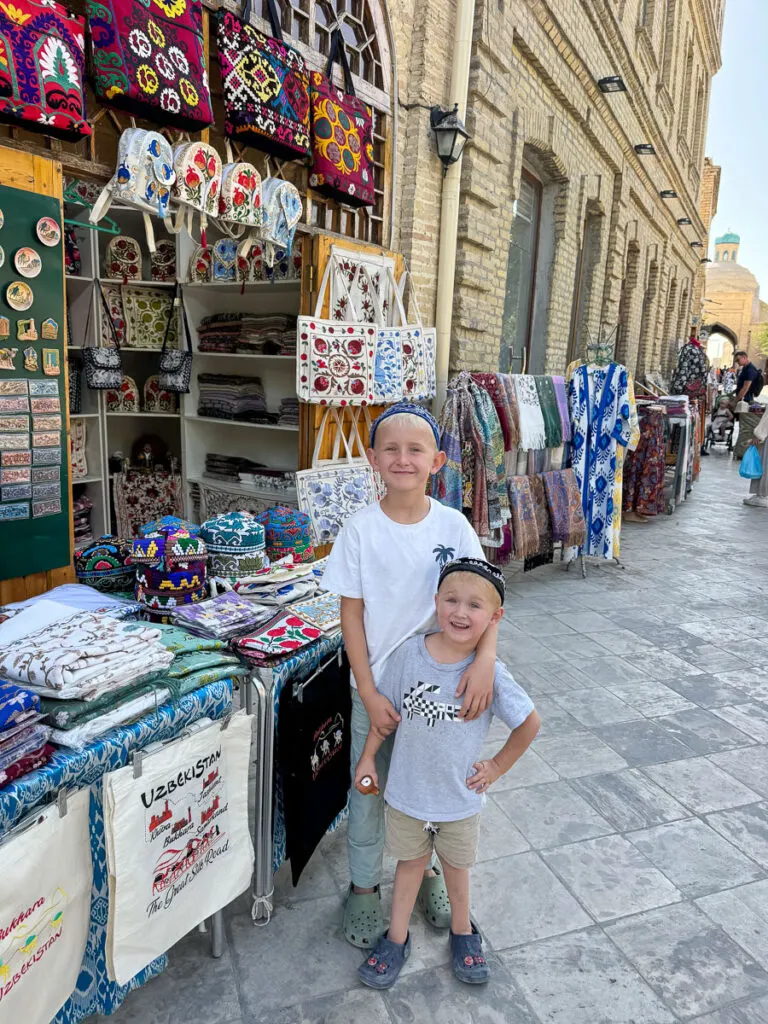
Spending time here felt like stepping back through layers of Silk Road history while still enjoying the warm welcome of a lived-in community.
Wandering the Pedestrian Old Town and Lyab i Hauz Pond
We loved simply wandering the pedestrian cobbled streets of old Bukhara, letting curiosity lead us into quiet alleys and shaded courts.
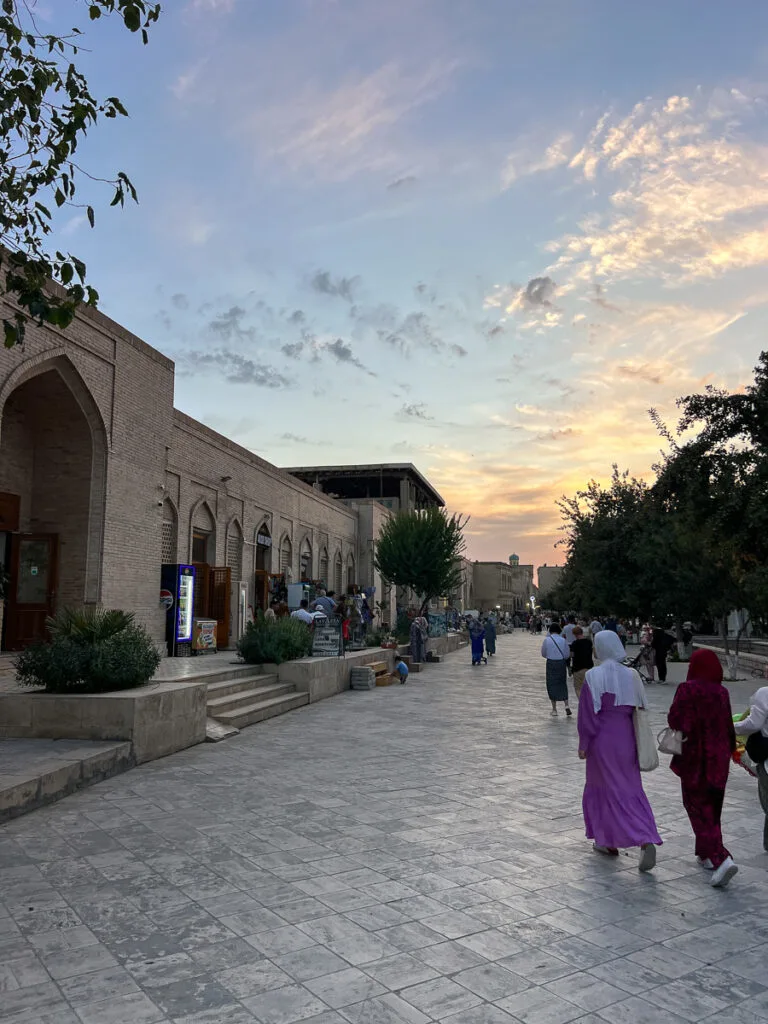
At its heart is Lyab-i-Hauz pond, a serene water basin with swans gliding on its surface and teahouse tables arranged around its edges.
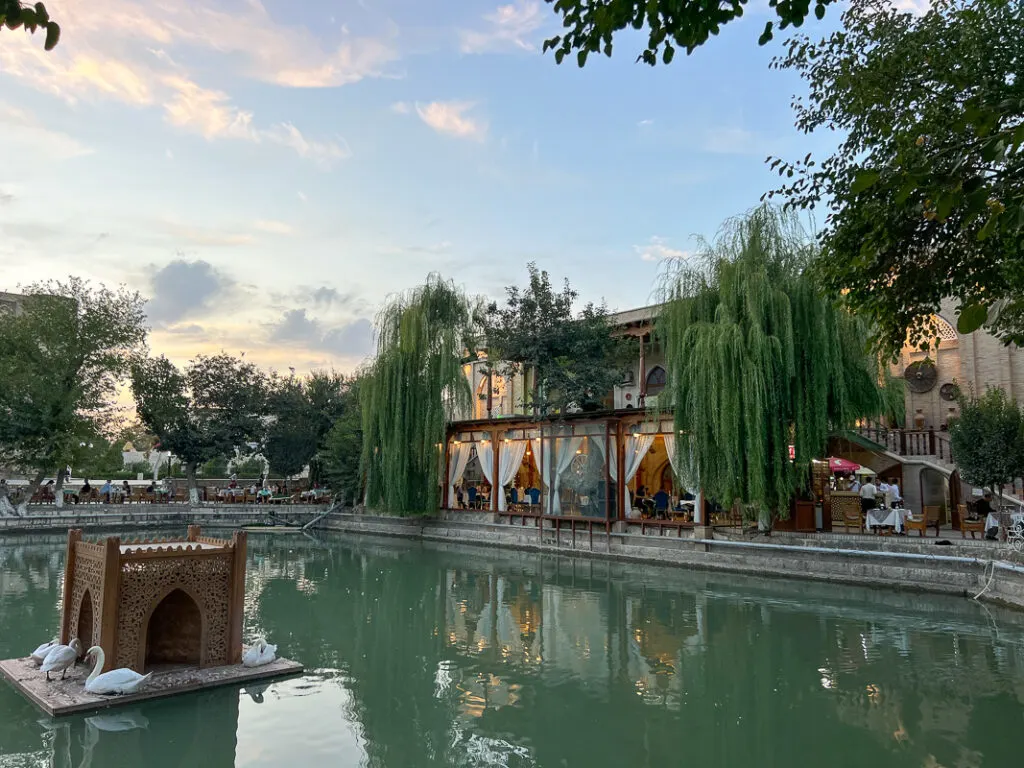
It became our favourite spot to pause with the kids, sip tea, enjoy baklava and watch daily life drift by. The pond and its surroundings feel like the city’s living room, central to many walking routes in our itinerary for Uzbekistan with kids.
Chor Minor Four Minarets
Hidden in a residential lane northeast of Lyab i Hauz, Chor Minor (literally “Four Minarets”) is small but enchanting.
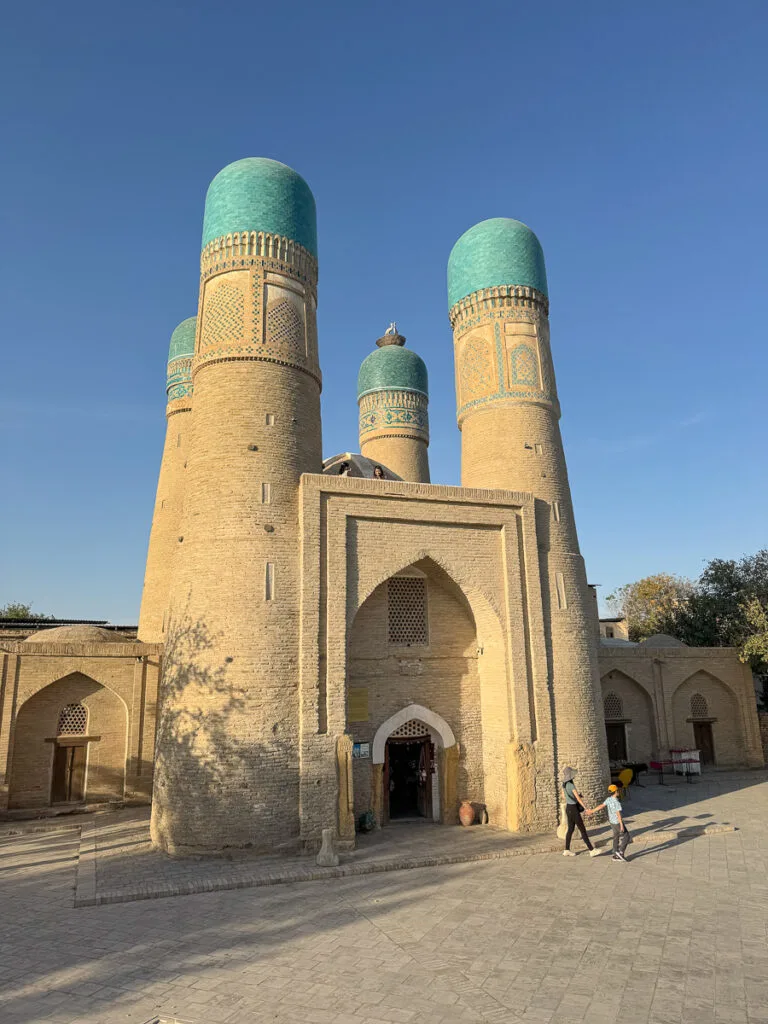
Built in 1807, it was initially part of a larger madrassah, now vanished. Its four towers are decorated in different motifs, and you can climb up one side for a quiet vantage over rooftops. It intrigued us as much for its mystery and scale as for its craftsmanship.
Abdul Aziz Khan Madrassah
Situated near the main squares, Abdul Aziz Khan Madrassah is one of Bukhara’s most central educational monuments.
Its lofty arches and carved entrances speak of a time when this city was a centre of learning and trade. From there, we could dip into nearby markets and enjoy the flow of life around us.
Poi Kalyan Architectural Ensemble
The Poi Kalyan complex is often referred to as the architectural heart of Bukhara. It consists of the Kalyan Minaret, Kalyan Mosque and the Miri Arab Madrassah.
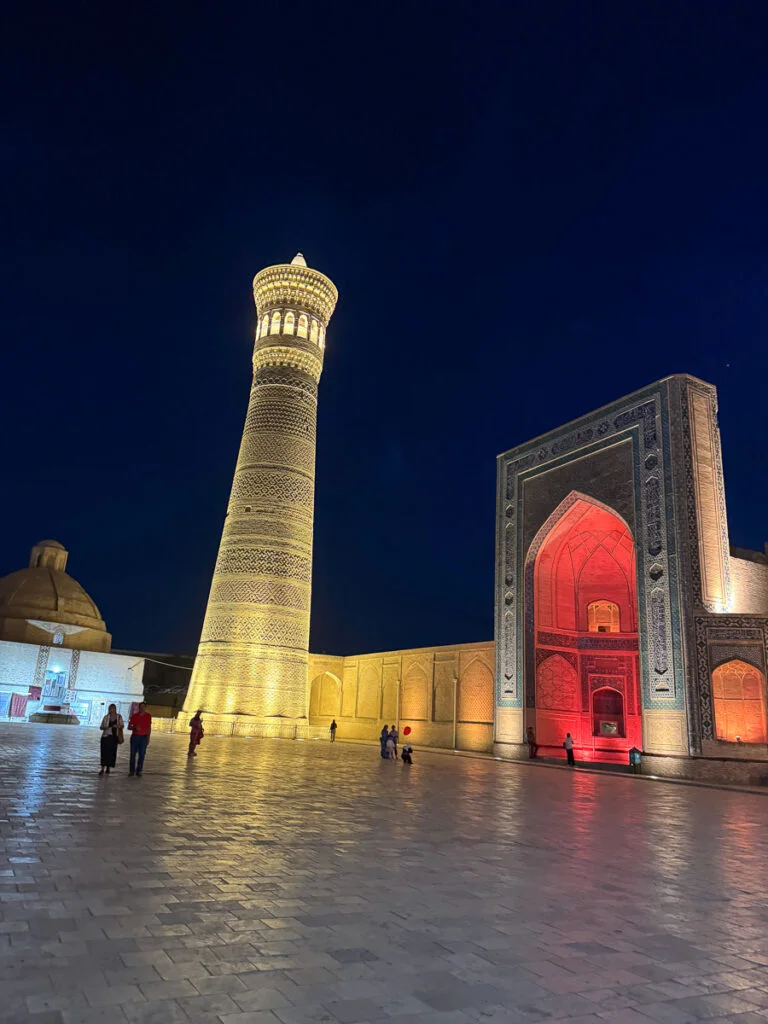
The minaret, built in 1127, has withstood centuries, and legends abound; some say Genghis Khan spared it. The mosque and madrassah combine to create an awe-inspiring open courtyard, perfect for kids to explore and adults to pause and take in the scale.
Art Installations and Contemporary Creativity
While Bukhara is steeped in ancient heritage, the city is now also embracing modern art in surprising ways. In 2025, the first Bukhara Biennial launched, weaving contemporary installations through historic sites.
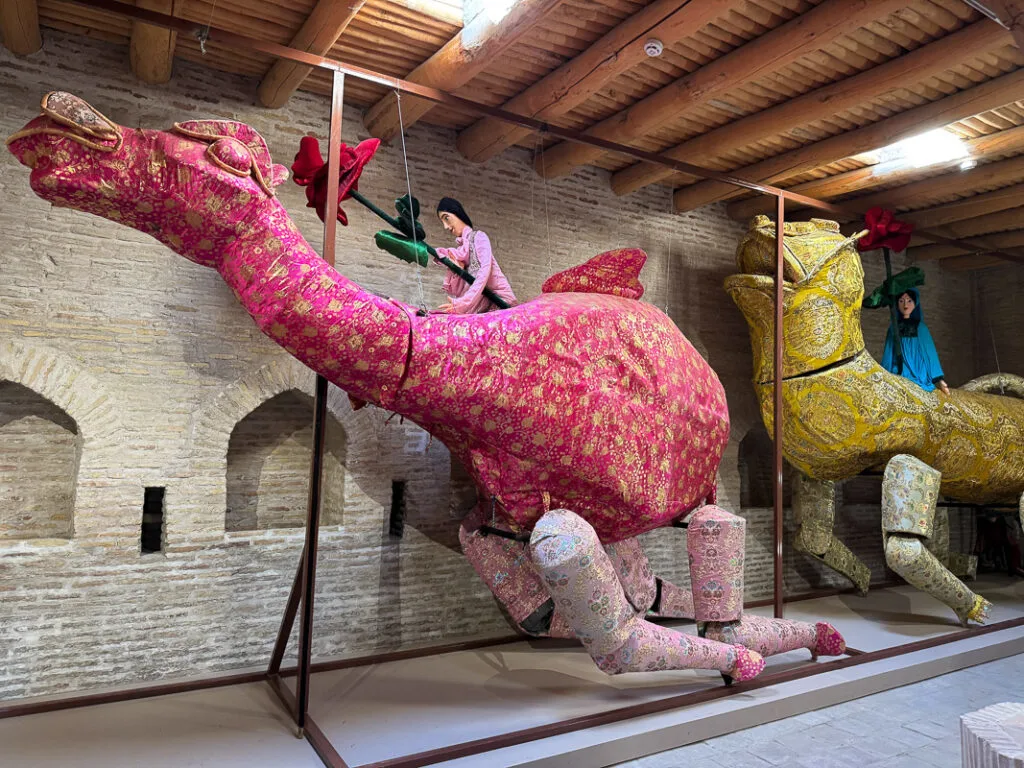
Artists collaborated with local artisans to create immersive works such as marbled paper rooms featuring pomegranate motifs by Uzbek artist Davlat Toshev, offering fresh visual surprises for both kids and adults.

Our kids were completely enchanted by one installation, a crumbling ruin transformed into a playground of giant cushions. They spent ages leaping, stacking, and building forts, and the whole scene felt almost dreamlike.
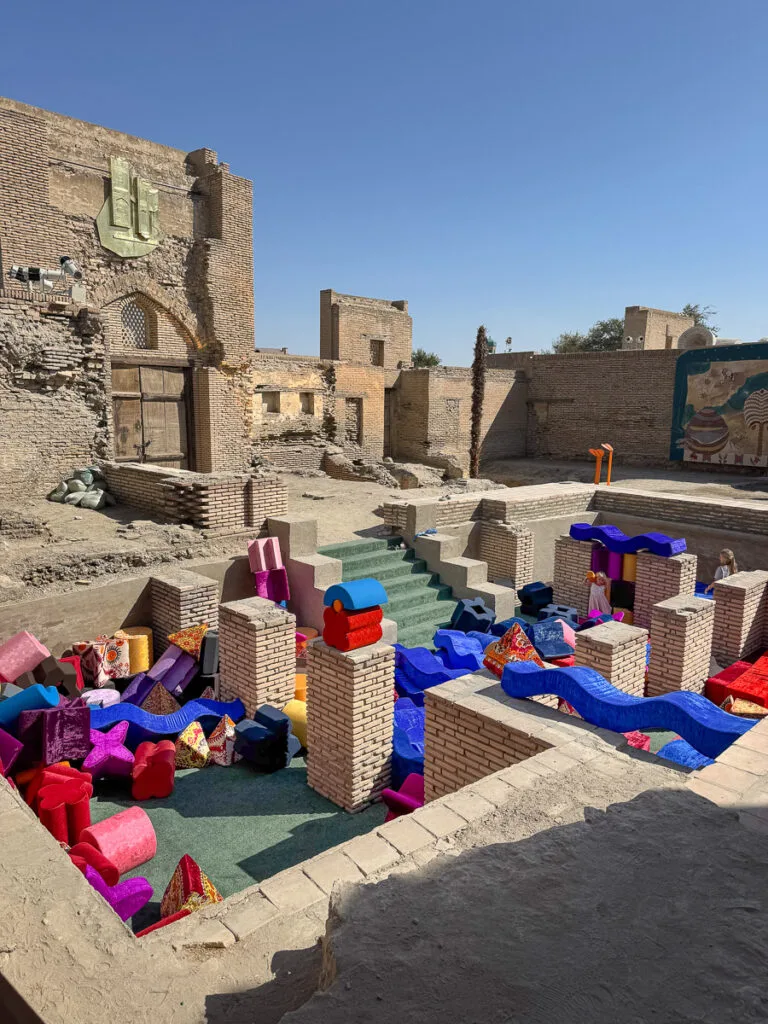
These installations help give a new lens to the old city, and we found them delightfully unexpected.
Markets, Covered Bazaars and Textile Temptations
Between squares and monuments, we passed through beautiful arched covered bazaars. Many buildings connect one plaza to another, featuring vaulted ceilings and corridors lined with stalls filled with carpets, patterned clothes, textiles, and handicrafts.
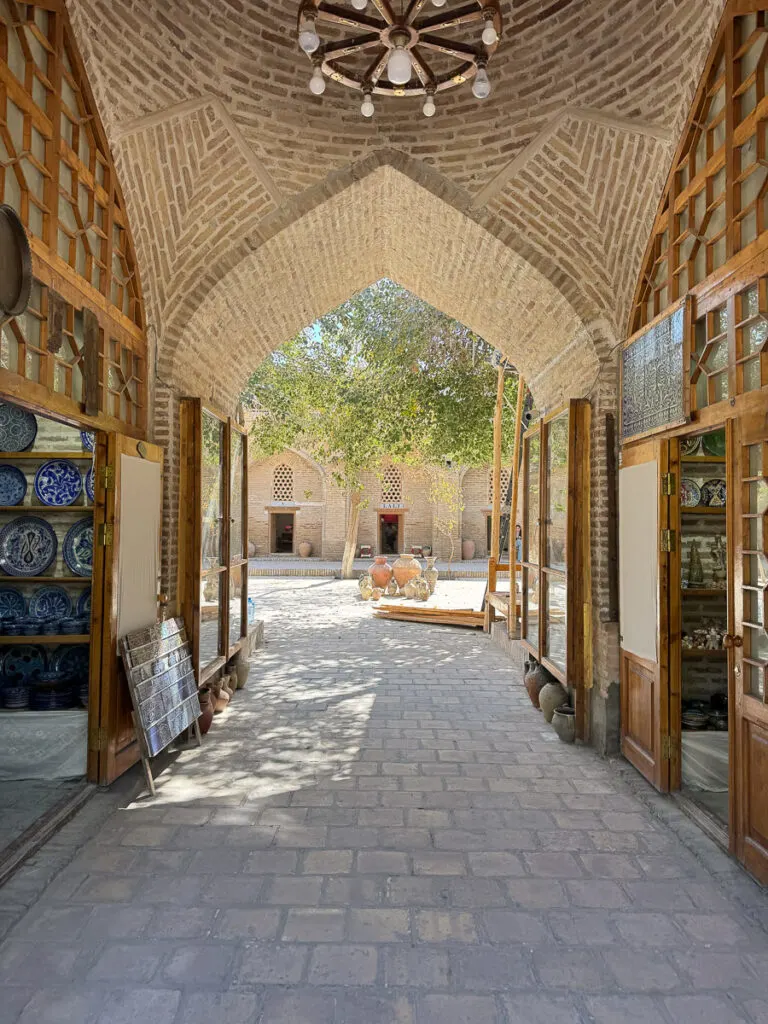
We found it nearly impossible to walk past without wanting to stop, touch and bargain. I really wish we could have taken home more, however as we were on a long trip of the region including Tajikistan and Kyrgyzstan, we couldn’t fit much more in our suitcase.
Restaurant and Cafe Recommendations
For a special meal outside the tourist centre, Zaytoon offered excellent food, drawing both locals and travellers.
We also loved Old Bukhara and Ayvan, the latter for its elegant internal architecture with arched windows, carved details and a calm ambience ideal for a family dinner.
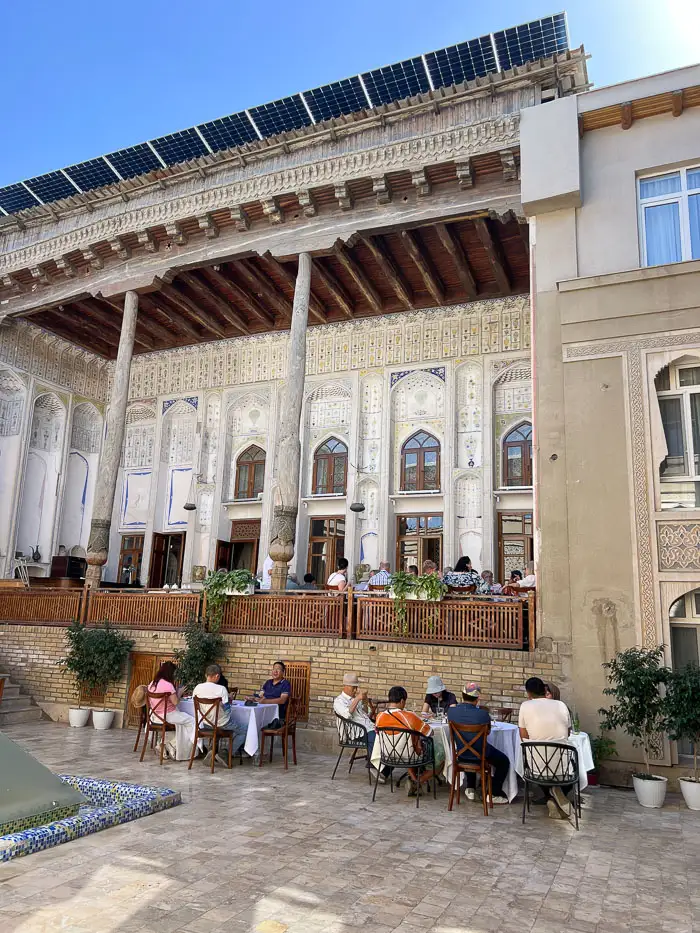
For lighter moments, we popped into cafes serving rich Uzbek coffee and doughnuts and Bon Patisserie perfect for a mid-day treat.
Food and Flavours of Uzbekistan
Sampling the local cuisine was a highlight of our itinerary for Uzbekistan, and we were amazed by the variety of dishes and the skill that goes into making them.
Somsa
Somsa quickly became our favourite street snack. These flaky pastries are stuffed with spiced lamb, beef, potato or pumpkin and baked inside a blazing hot tandoor oven.
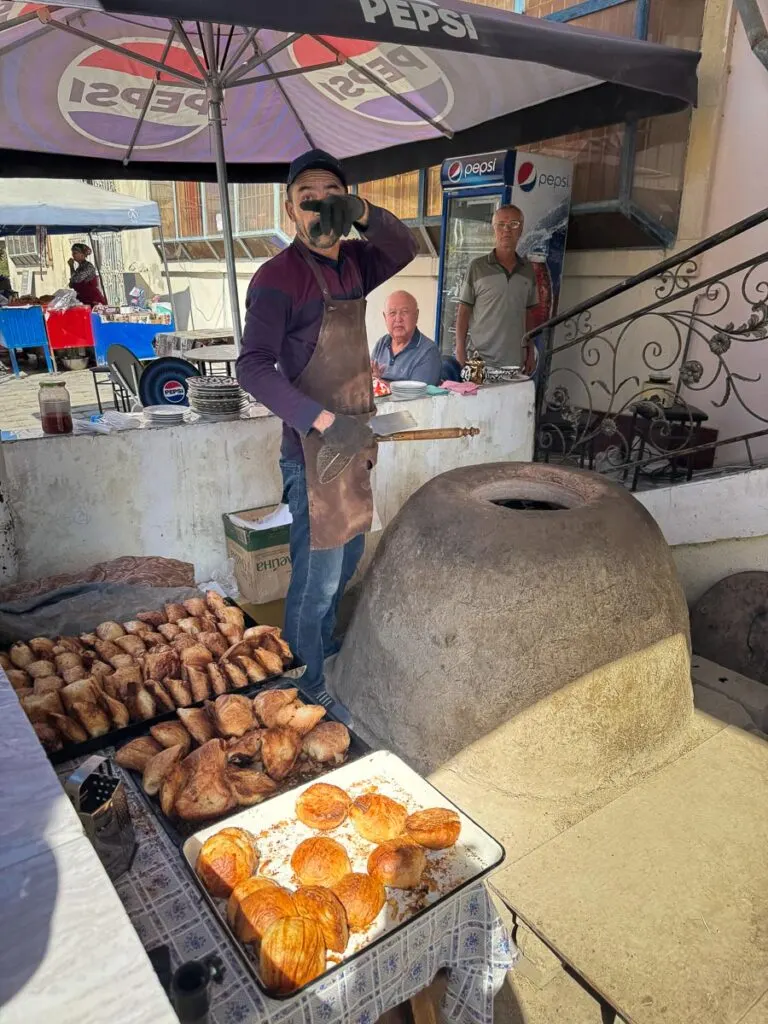
Bakers press each pastry to the clay wall and pull it out once the crust is golden and crisp. Watching the process is almost as enjoyable as eating the result.
Plov
Plov is the country’s signature dish, and no visit is complete without it. Rice, carrots, onions, and lamb are slow-cooked in giant iron cauldrons over open flames until the grains soak up the fragrant oil.
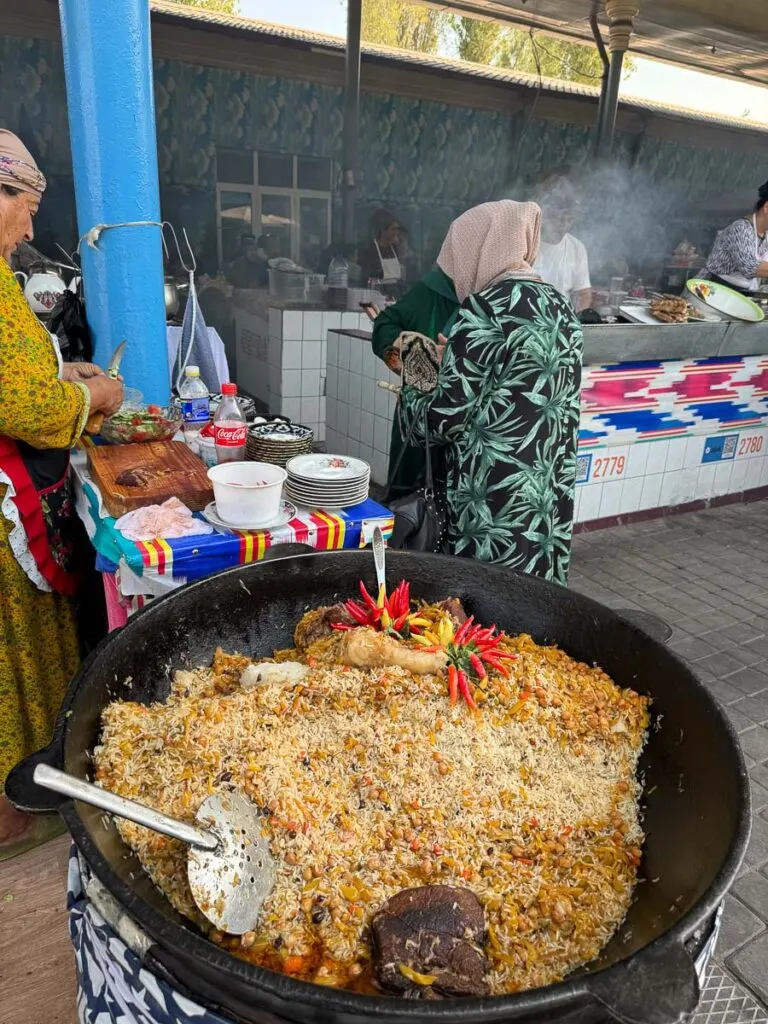
Each region claims to have the best version, and tasting a few is half the fun. We are vegan so it was easy enough to ask for a meat free version.
Lagman
Lagman is a hearty noodle dish featuring a rich, slightly spicy broth, accompanied by a generous mix of vegetables and meat. You will find both soup and stir-fried versions, each with hand-pulled noodles that give the dish its comforting texture.
Shashlik
These skewers of marinated meat are grilled over charcoal and served with sliced onion and a splash of vinegar.
Manty and Chuchvara
Manty are large steamed dumplings filled with minced meat and onion, sometimes pumpkin, and often topped with a spoon of sour cream. Chuchvara are smaller dumplings served in broth, perfect for cooler evenings.
Sweet Treats and Drinks
Tea is the drink of choice everywhere. We were constantly offered green tea poured from ornate pots into small cups. Markets also tempt with local halva and nut-based sweets that pair perfectly with tea.
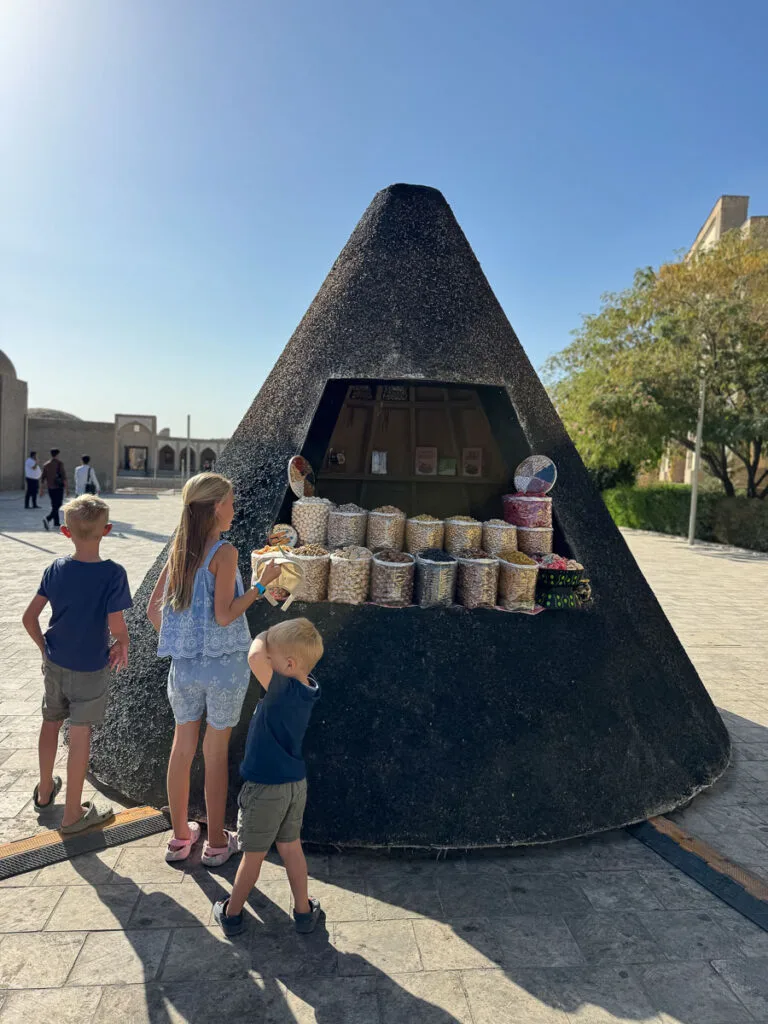
Exploring these dishes was one of the best parts of travelling through the country. From roadside stalls to busy bazaars and family kitchens, the food scene adds depth and flavour to any itinerary for Uzbekistan with kids.
Final Thoughts on Our Itinerary for Uzbekistan
Travelling through Uzbekistan has been one of the most rewarding family journeys we have taken. From the calm charm of Tashkent to the turquoise domes of Samarkand and the storybook lanes of Bukhara, every stop on our itinerary for Uzbekistan revealed a country that is both steeped in history and full of life today.
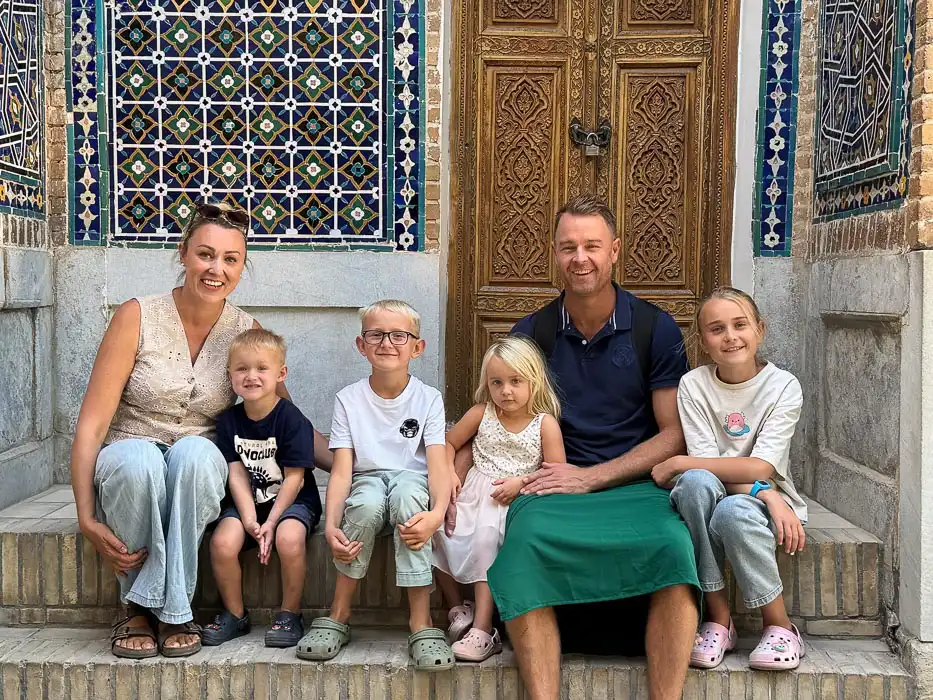
We came for the Silk Road architecture and world-class monuments, but were just as captivated by the warmth of the people, the incredible cleanliness of the cities and the flavours of the food.
From steaming somsa pulled from clay ovens to the perfect plate of plov. Friendly locals greeted our children with smiles, shared tea, and made us feel welcome at every turn.
Uzbekistan offers a mix of comfort and discovery that is hard to match. High-speed trains, easy eSIM connections, and simple money transfers mean the logistics are straightforward, leaving you free to enjoy the sights, tastes and traditions of this remarkable country.
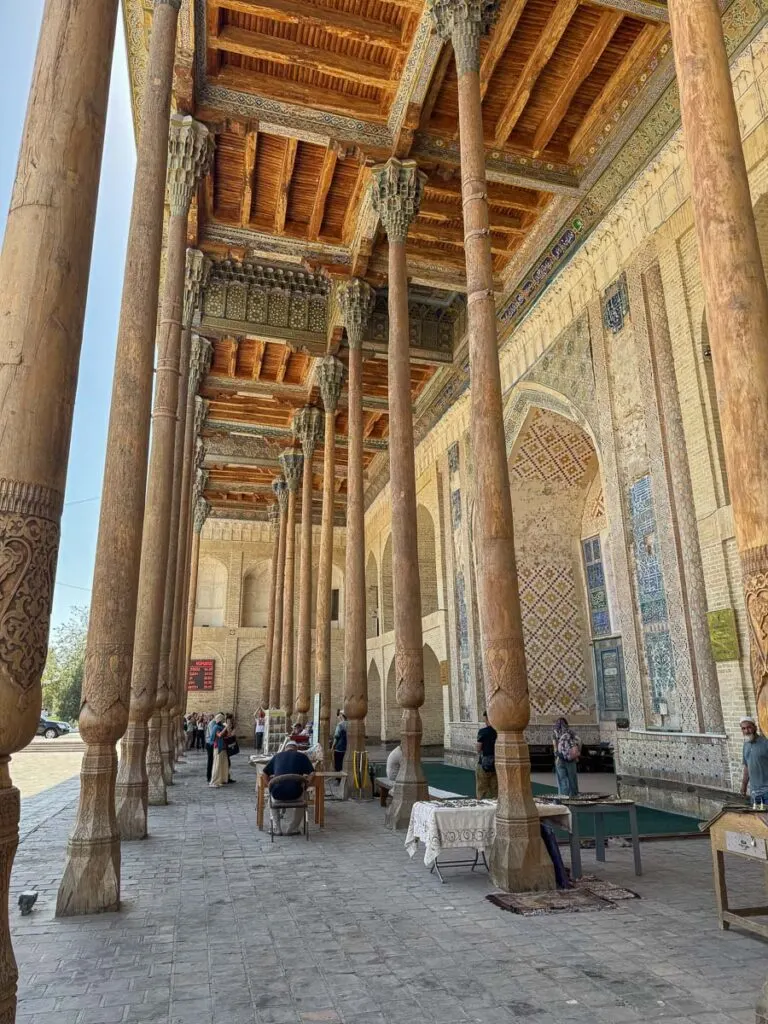
If you are mapping out your own itinerary for Uzbekistan, give yourself time to wander, taste, and talk with the people who make these ancient cities so memorable. This is a destination that rewards slow travel and curious hearts, and we left already dreaming of when we might return.
Disclaimer: This post may contain affiliate links, by using them it will not cost you any extra, we mat receive a small commission to keep us writing.
